Travels with Dick and Karen
Britain Part 3
Edinburgh back to the SE
|
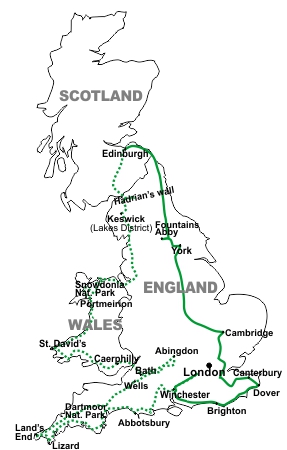 |
| Enroute to Edinburgh, we stopped in the little town of Biggar seeking groceries (it was too small). With posters like this, we knew we had entered Scotland. The debate on whether to stay in the union culminates in a vote in mid September. |
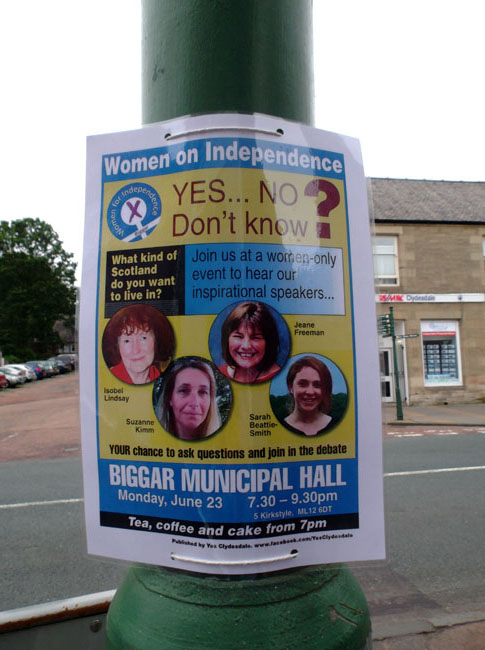 |
| That night's campground on the outskirts of Edinburg had a pair of very wooly horn-bearing cattle grazing by the road. |
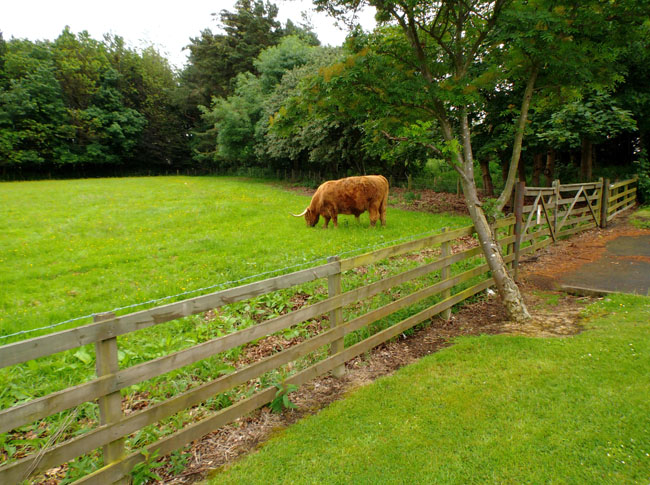 |
And the following sign on the fence -- I don't know that I'd want to walk across a field owned by horns like that. |
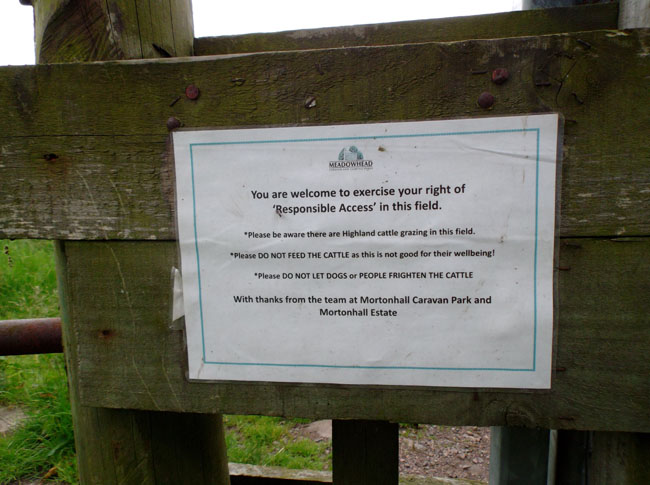 |
After checking out a bit of the city (and lack of parking) we walked from the campground to the city bus stop just outside its gate. |
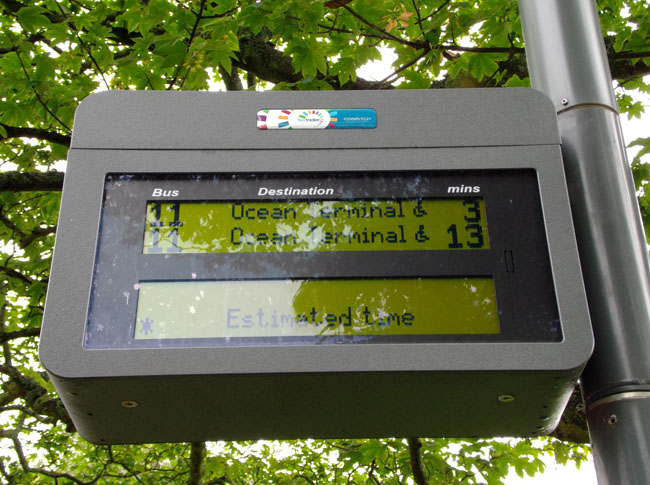 |
| And zipped into town to visit our Seattle next-door neighbors the Keils, who had been in Edinburgh on sabbatical for a year (again we got so involved with the visit that we forgot to take photos). |
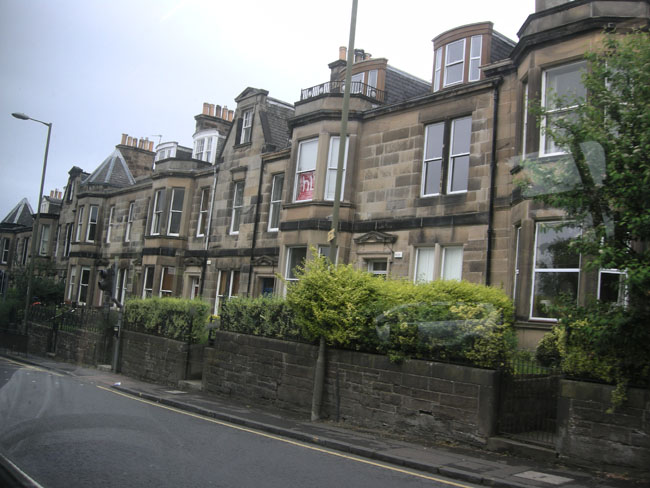 |
| We repeated the bus trip the next morning but continued all the way into town, passing Edinburgh's castle... |
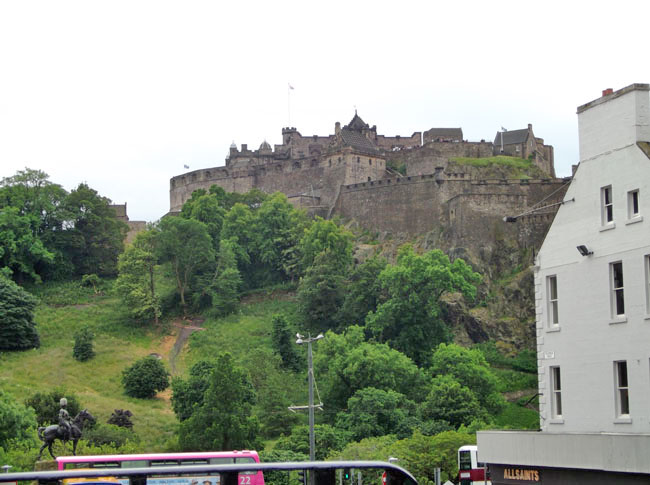 |
| ... and the back side of the older section ... |
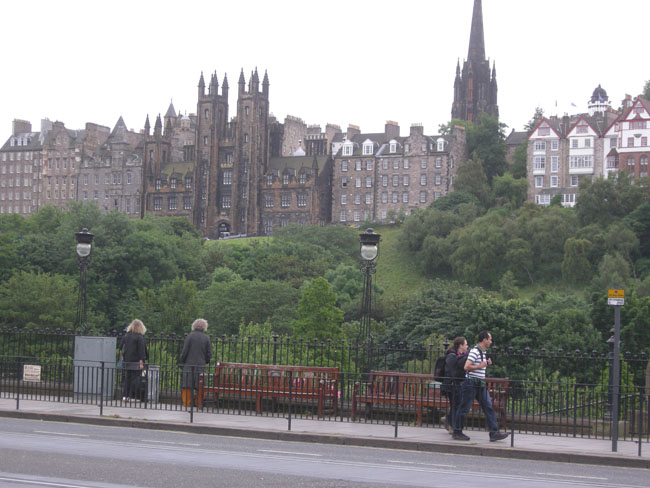 |
| ... to get to the Royal Botanical Garden. The palm house was under renovation |
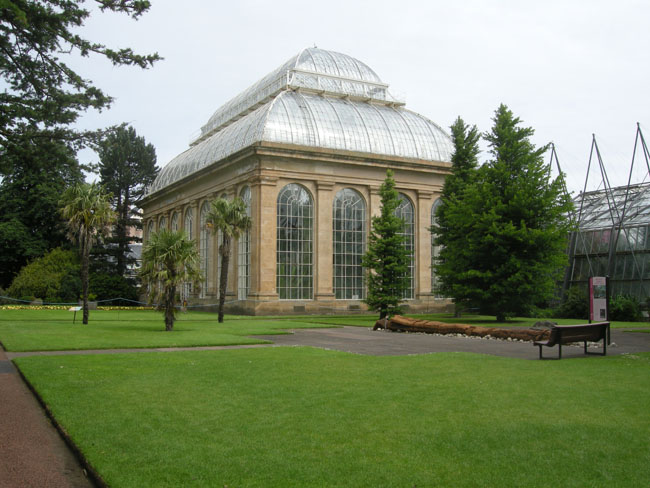 |
| so we could just look at the project from the outside |
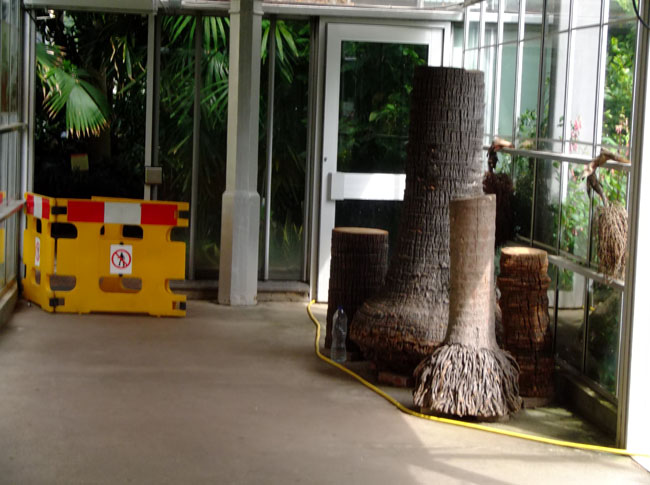 |
| But the rest of the green houses were fantastic |
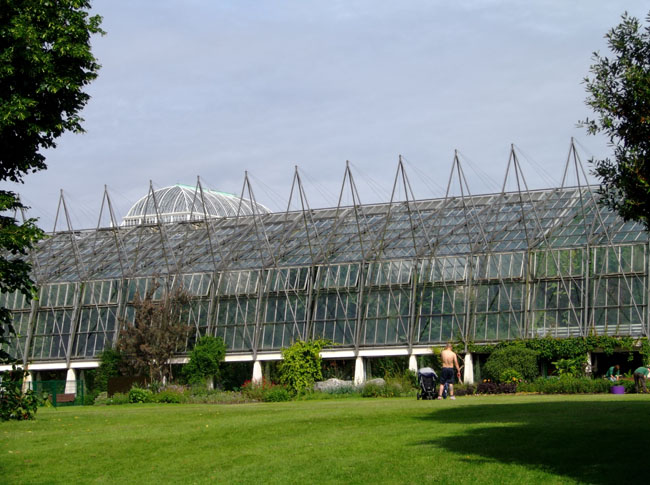 |
| A fine Cyprus, two stories tall |
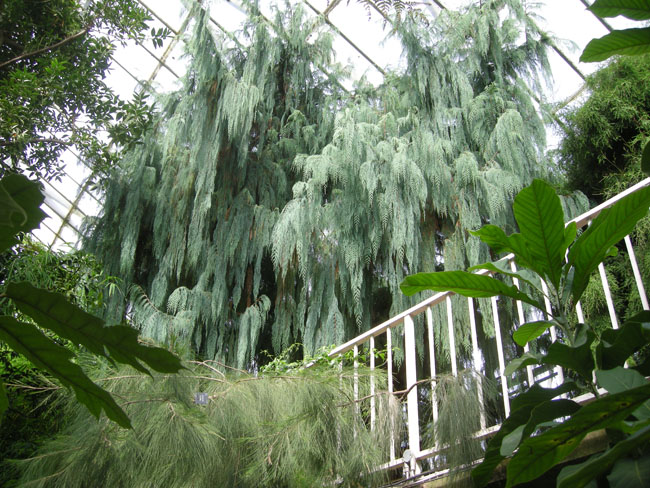 |
The second story(*) walk among the canopy
(* Brit: storey) |
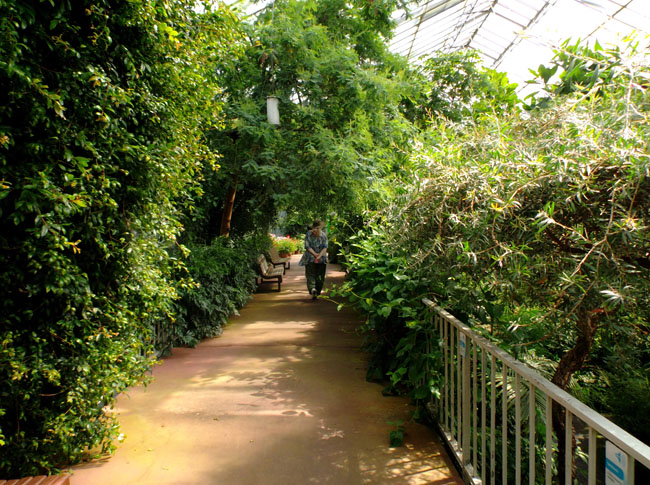 |
| Aristolochia grandiflora, one of the largest flowers in the world. In theory it smells like carrion but it is a vine on the wall and we didn't get close enough to smell it (and yes, they also have Amorphophallus titanum, the world's largest known flower, but it wasn't in bloom) |
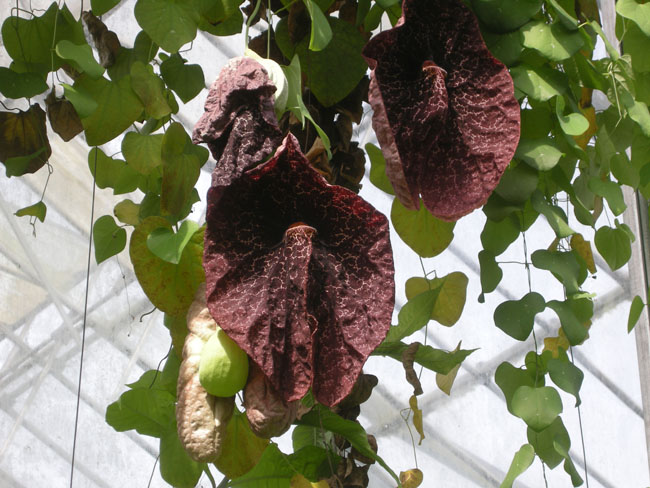 |
| Blue water lilies are one of Karen's favorites |
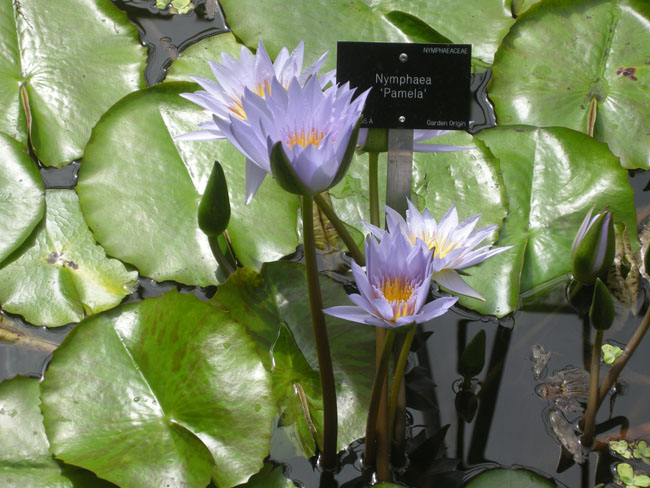 |
but dwarfed by the huge Victoria water lilies |
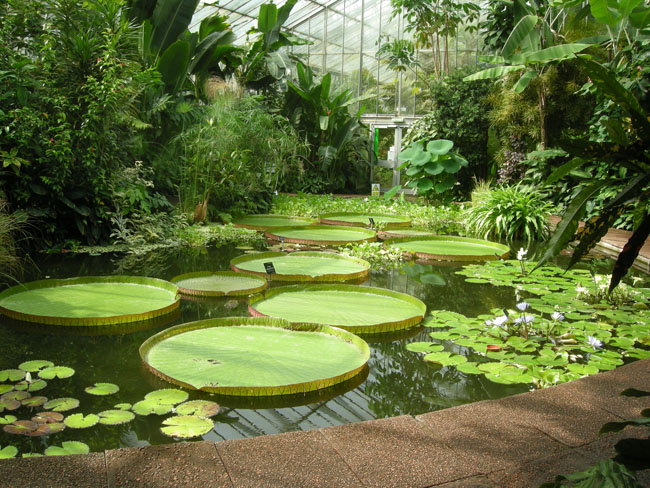 |
| They even had an exhibit of underwater tanks where the focus was on the plants as much as the fish (in most other museums they use plastic plants or just a few easily grown plant species). |
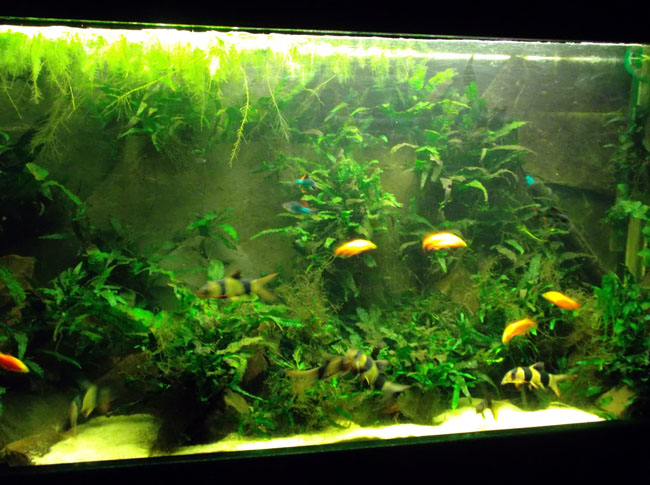 |
| The dry house grouped plants by regions of the world |
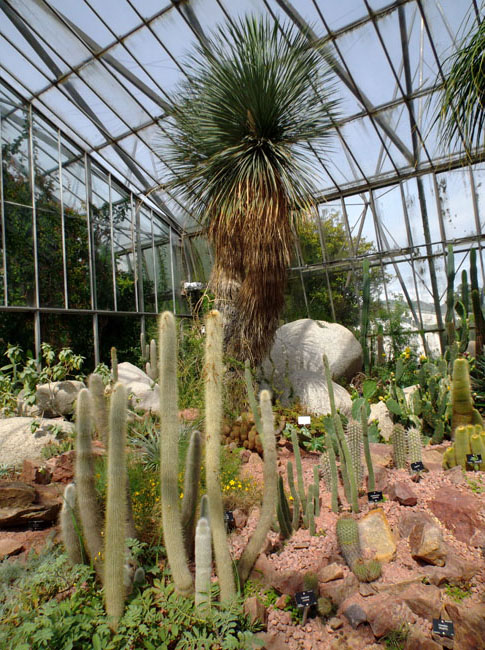 |
| And of course they had a fern house |
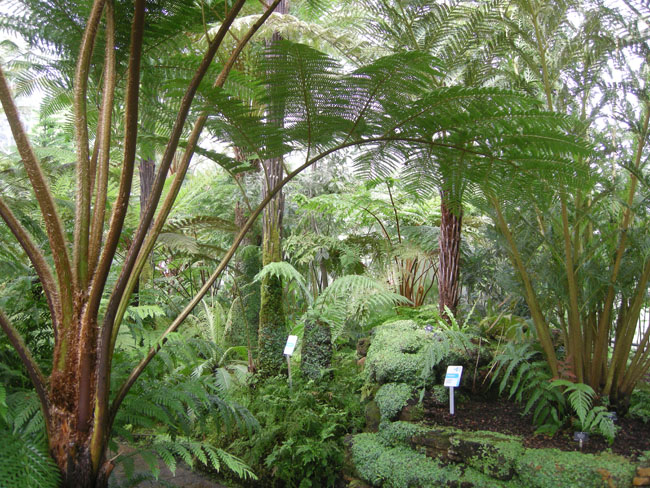 |
| The exhibits even carried into the restaurant where we had lunch: all the tables had the kind of wood marked on them. |
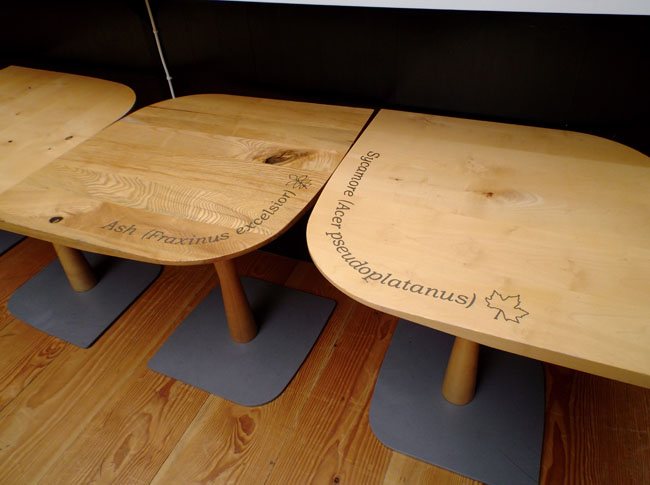 |
| Out doors was more typical British competitive gardening, |
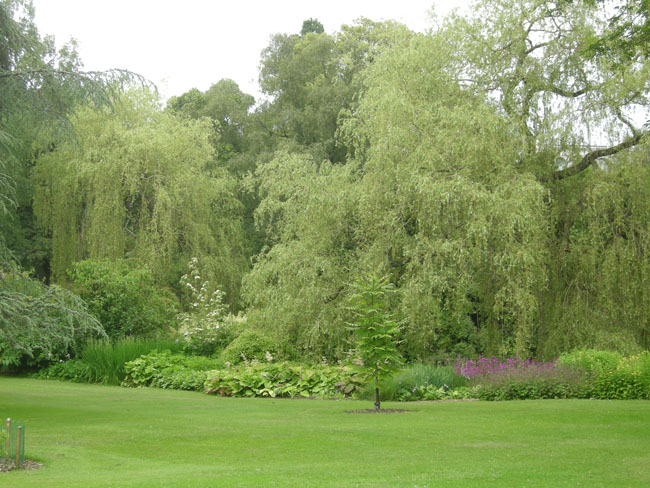 |
| including a tribute to the Queen mother |
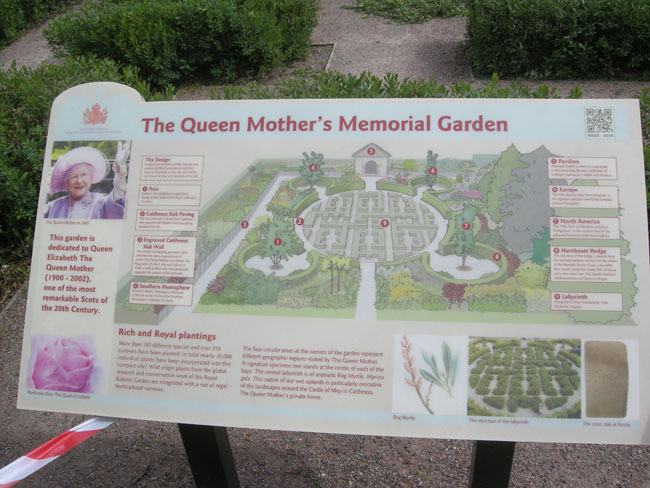 |
| with a small garden house decorated by school children's collected pine cones on the ceiling |
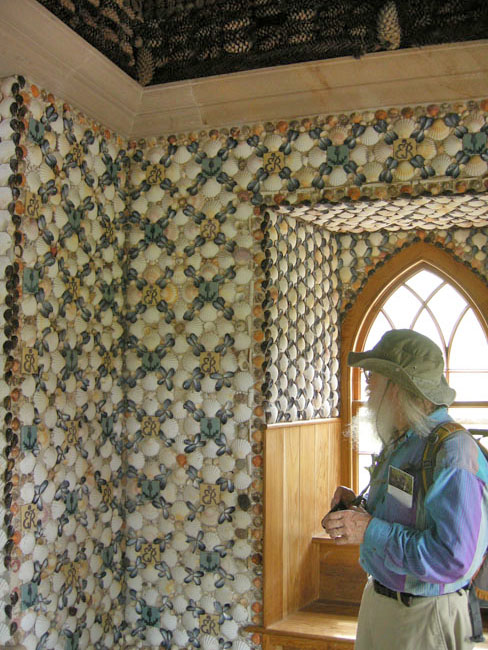 |
| and shells on the walls |
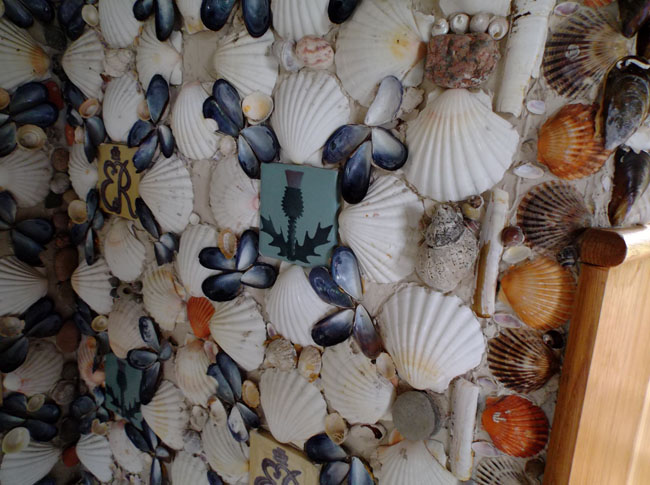 |
| There was an extensive chinese plant exhibit, detailing joint research with the institution whose gardens we visited in Menglun China in 2012. |
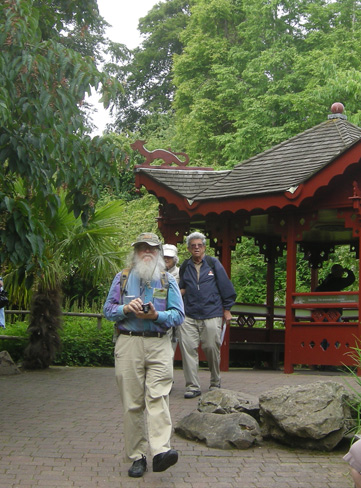 |
| The Botanical Garden also had views looking back south towards the main part of the old walled city on the adjacent hill |
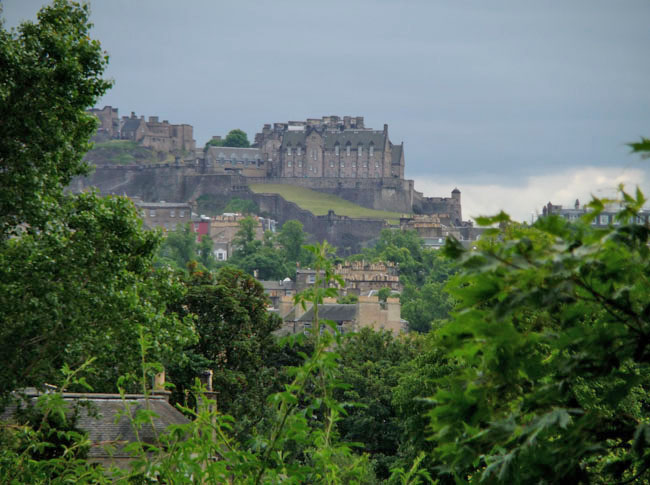 |
| ... and the neighborhoods to its west. |
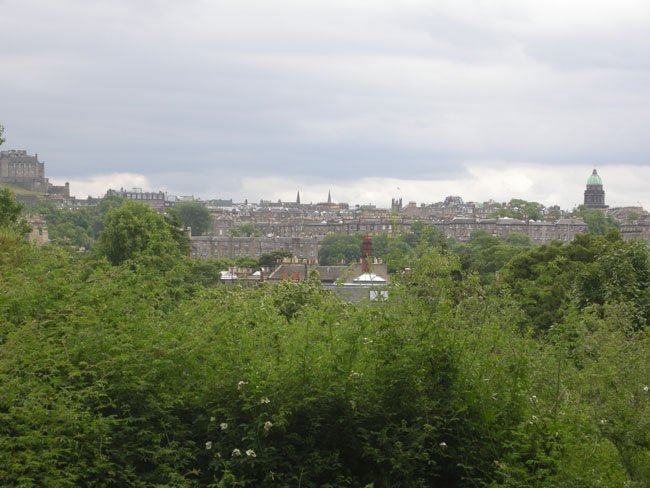 |
| In the afternoon we took the bus back up to the heavily touristed "Royal Mile" from the Castle to the Parliament. |
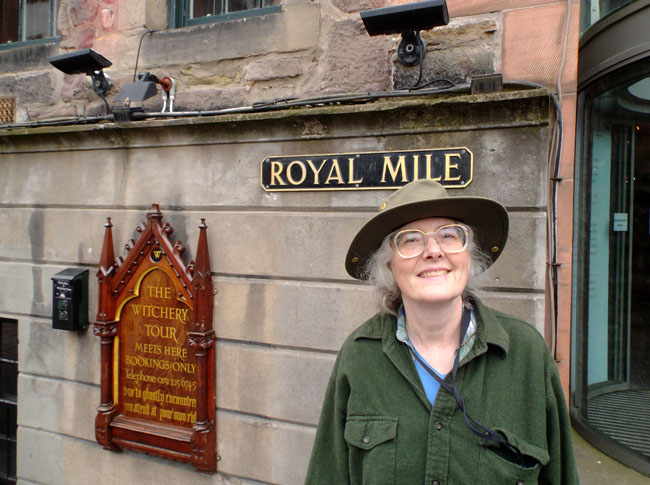 |
| |
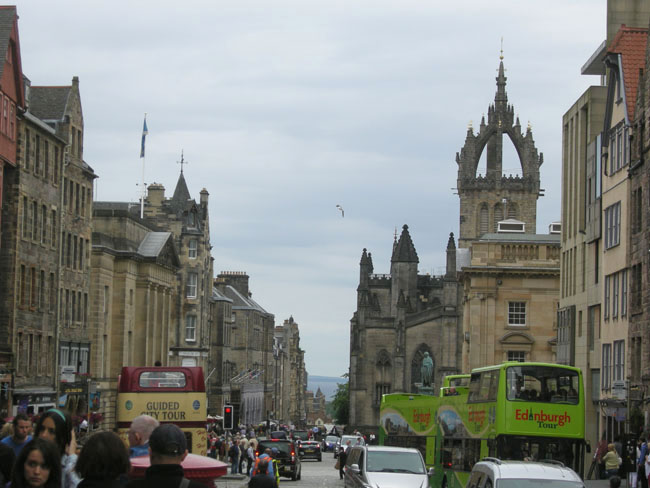 |
| |
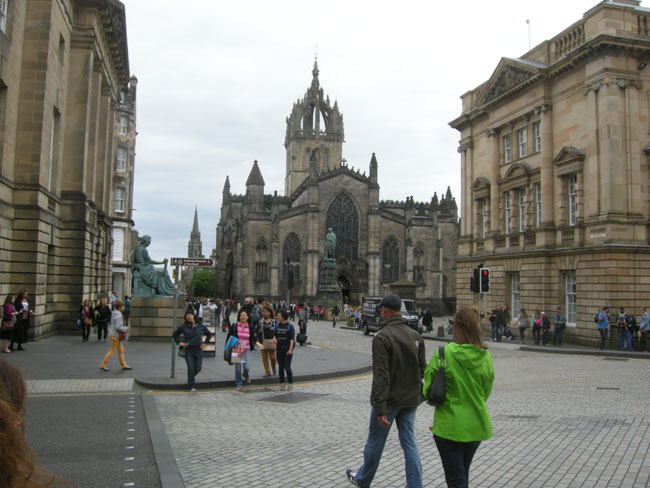 |
| Bits of history, pubs and gift shops oozing out of every pore... |
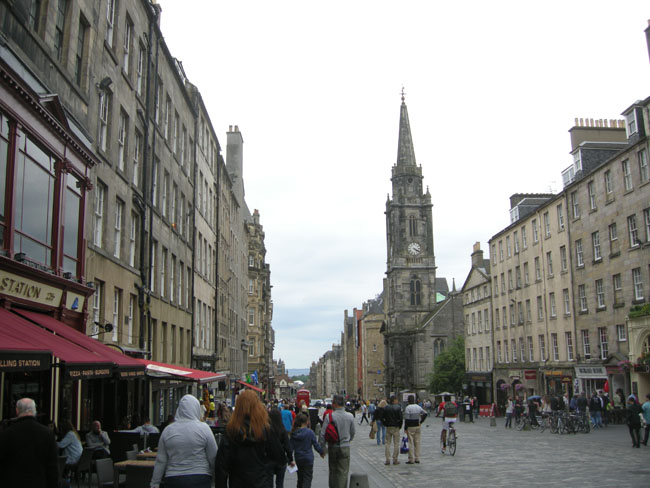 |
| ...lots of intriguing little pedestrian passageways lead off from the main road, either down to the next street or to an enclosed courtyard or "close". |
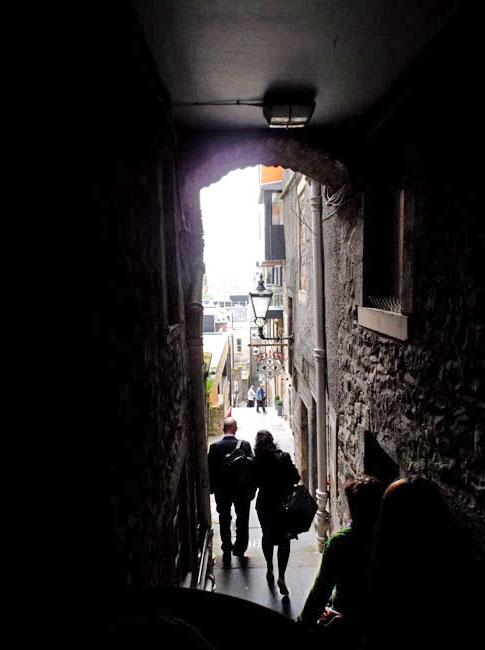 |
| |
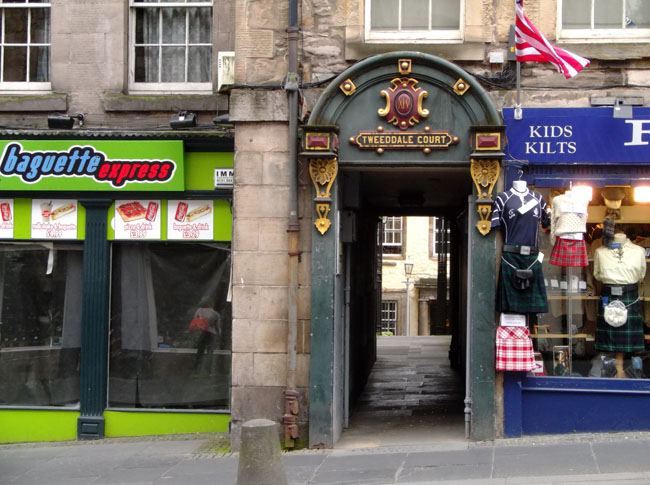 |
| The Writer's Museum at Lady Stair's 1622 House in Maker's Court. |
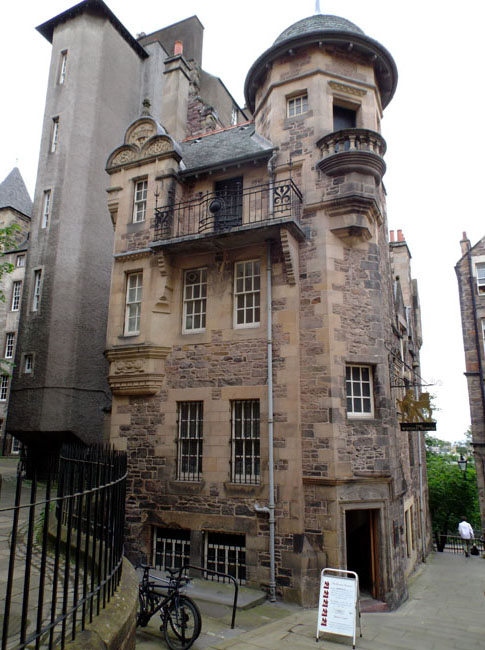 |
| The expected piper playing for tips |
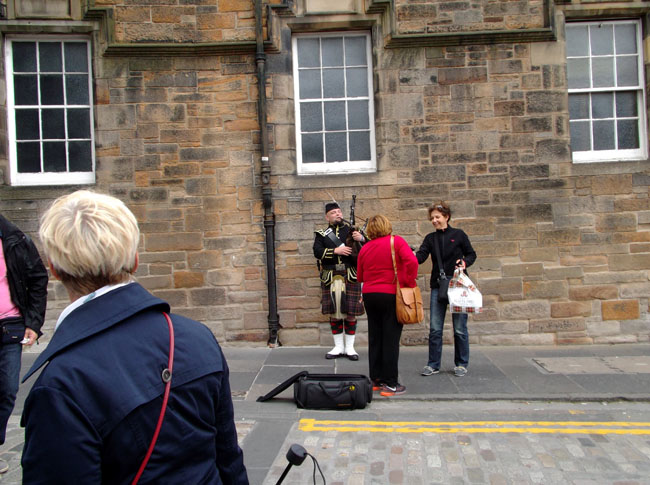 |
| Lots of Scottish kitsch |
 |
| and a less common act trying for tips. |
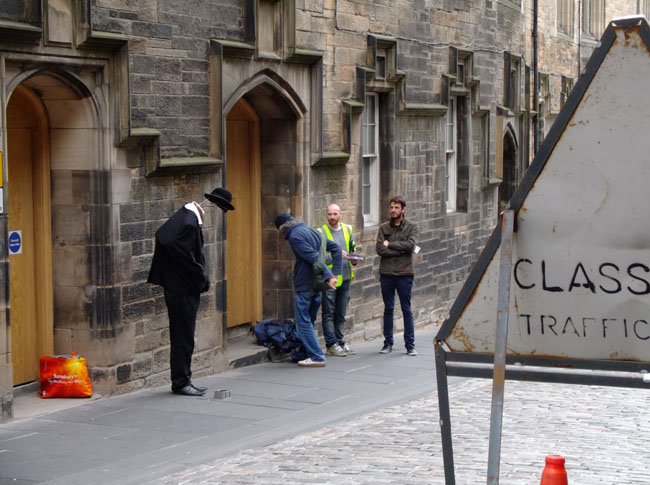 |
| We were amused by the Goblin Town model (from the Hobbit movie) displayed in the window of a Role-Playing Game shop (with active games going on inside the shop). |
 |
And who but the Scots would put up statues to economic philosophers?
Edinburgh and Scotland deserve another trip to see them properly. But we've got a little over a week to get the van back south and catch our plane so we reluctantly turned south the next morning. |
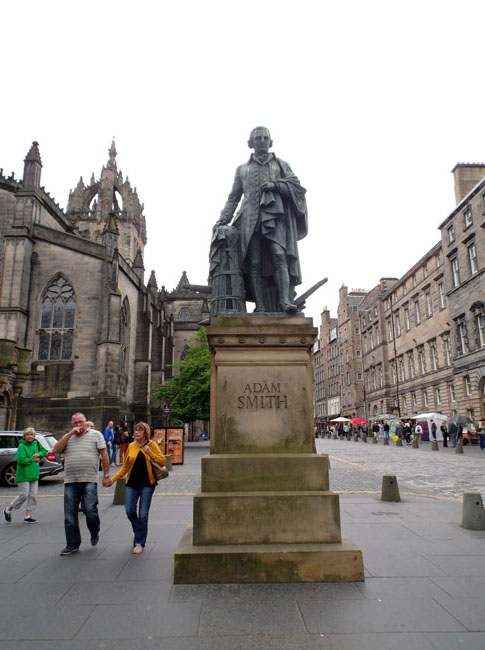 |
But along the way we did have a few more stops planned.
After following the eastern Scottish and English coast for a while, we turned inland at Newcastle Upon Tyne and headed to Ripon, where we found:
Fountains Abbey, another extensive ruin from King Henry VIII's dissolution of the monasteries |
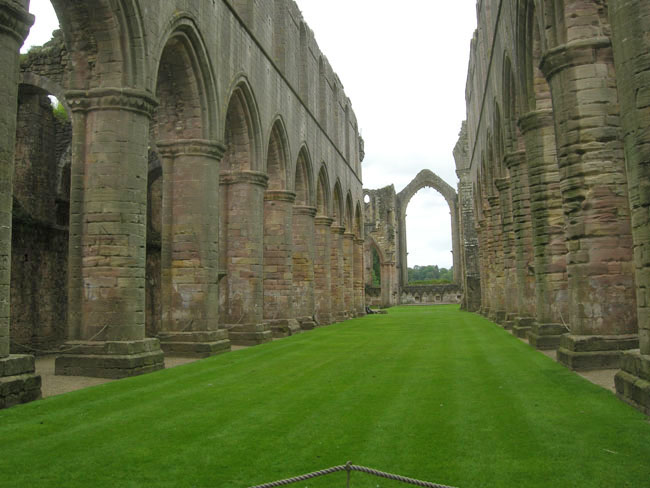 |
| |
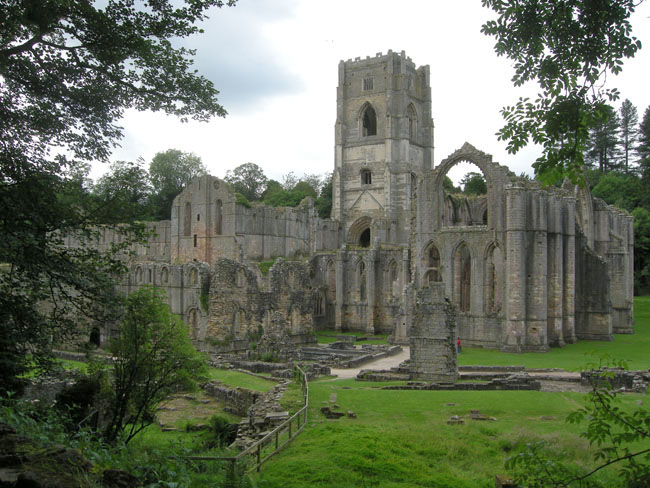 |
The adjacent small museum gave a capsule history of the site ... |
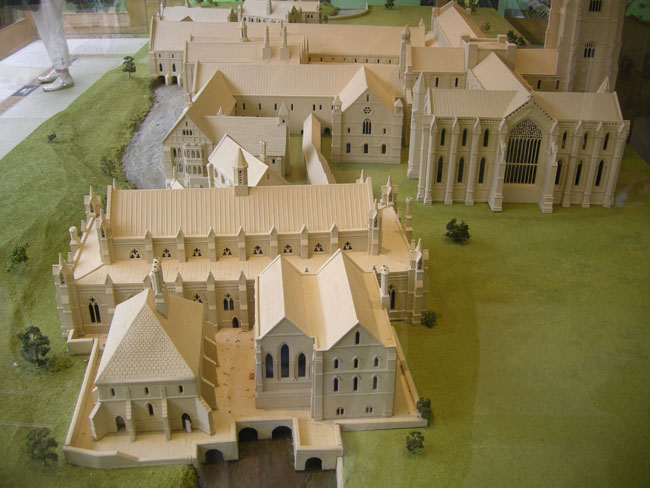 |
| |
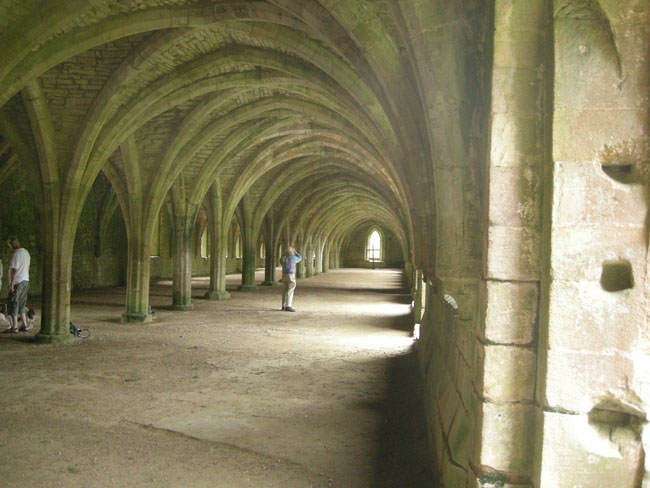 |
| |
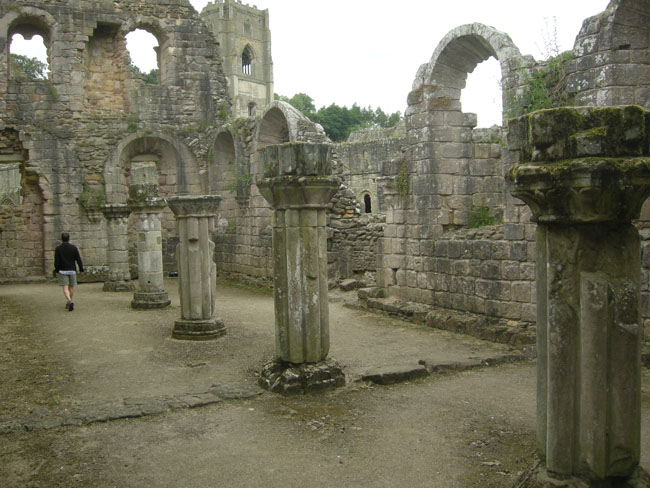 |
| ... which was undeniably impressive by its sheer scale. |
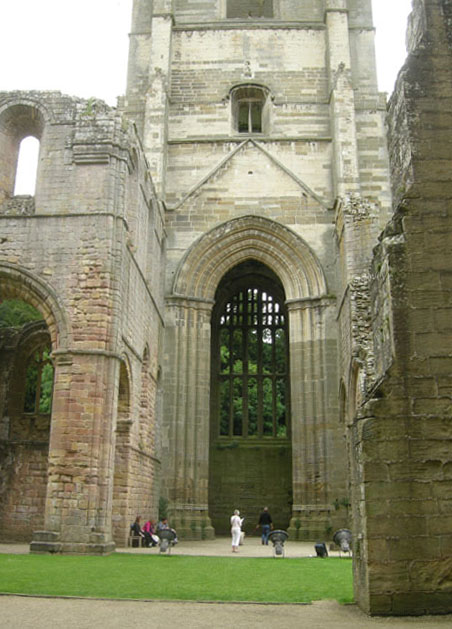 |
| |
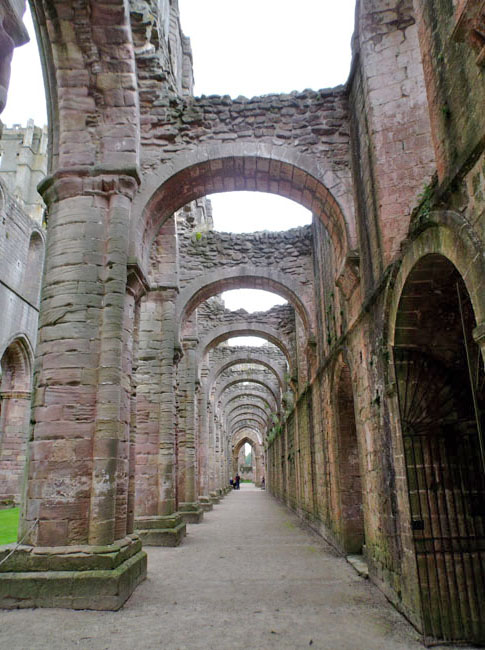 |
| |
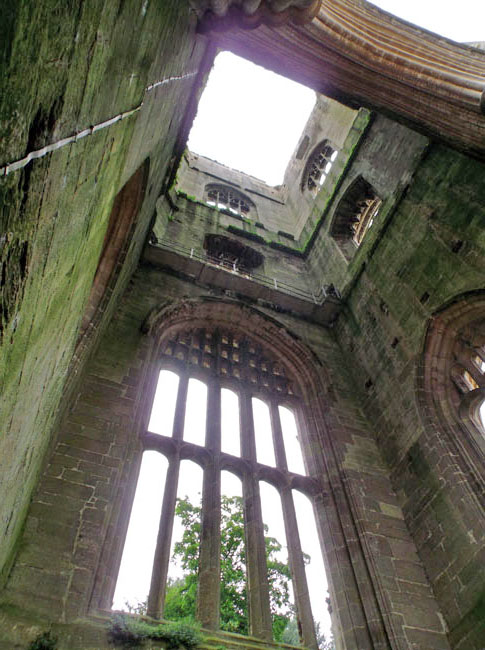 |
The ruins are contained in Studley Royal Park, a huge landscape-and-water garden which uses them and other more recently-built objects as focal points for vistas.
(The ruins are at the red arrow above the You Are Here flag) |
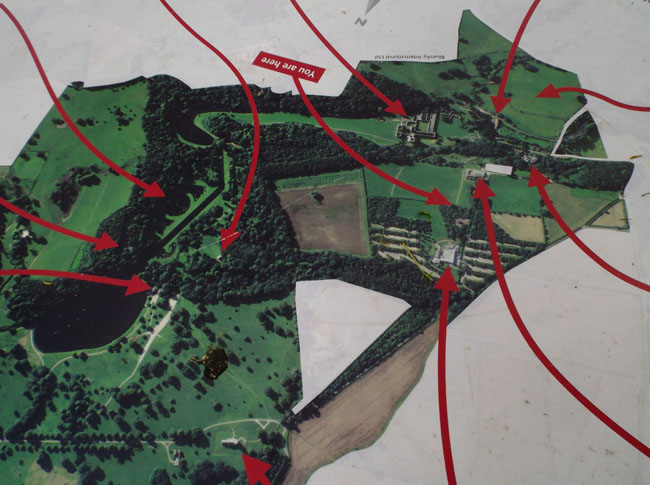 |
| |
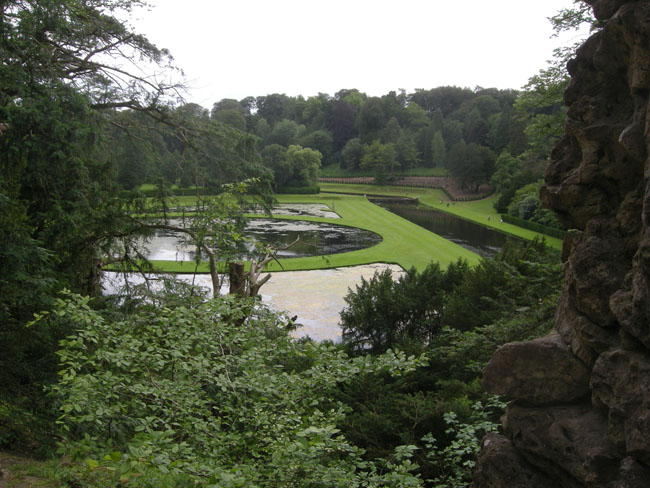 |
| |
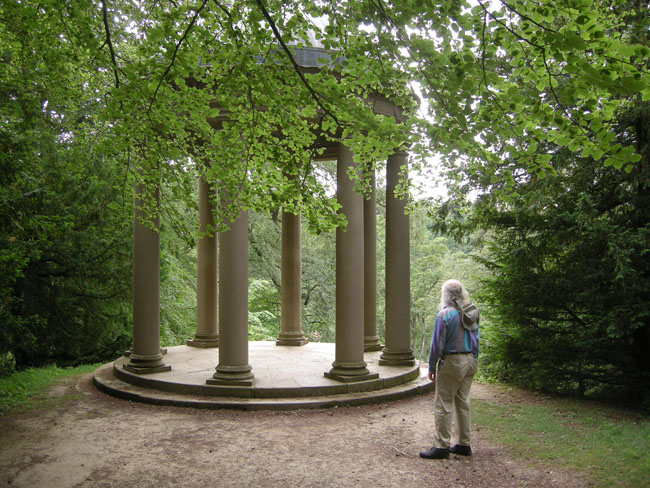 |
| Fountain Hall is a Jacobean mansion built circa 1600. It is under renovation and partially open to the public (but very musty). You can also rent a room or two. |
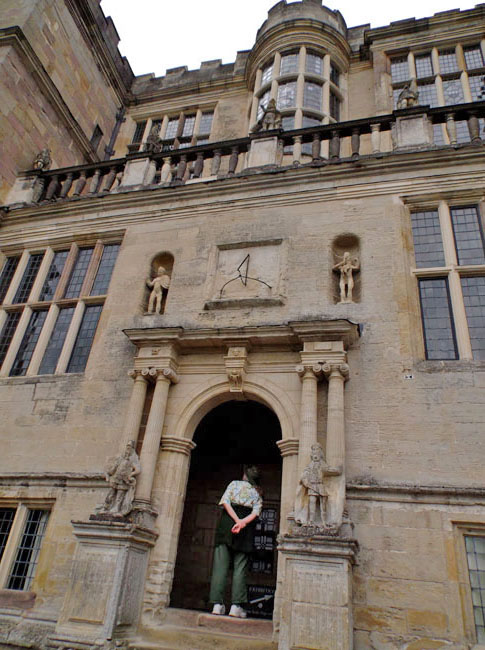 |
| We only stepped in to look at the main hall ... |
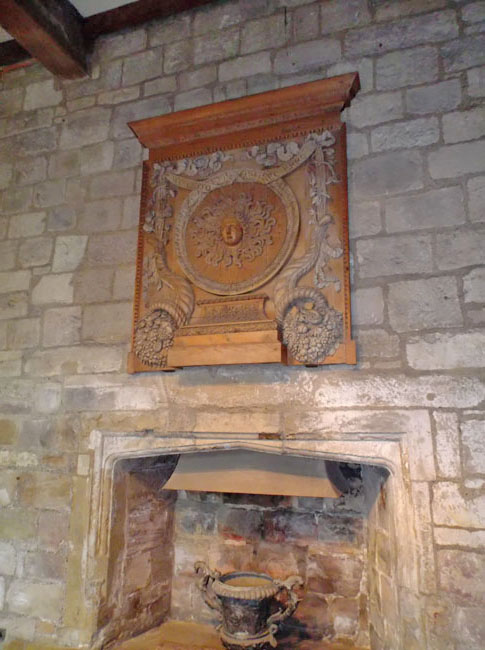 |
| ... and stepped back out again |
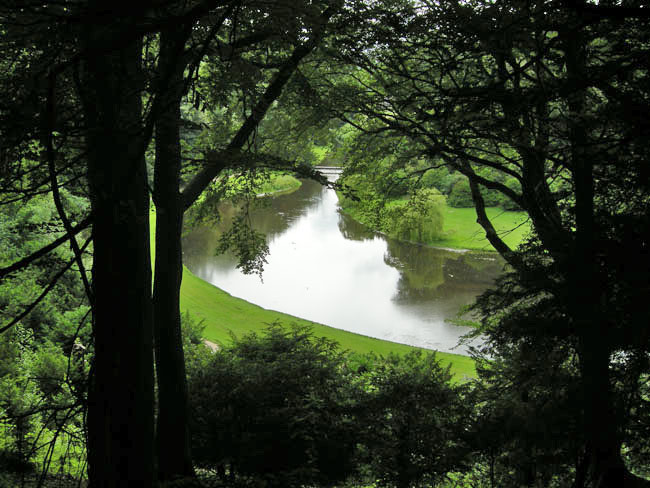 |
| That evening was again in a nearly empty campground |
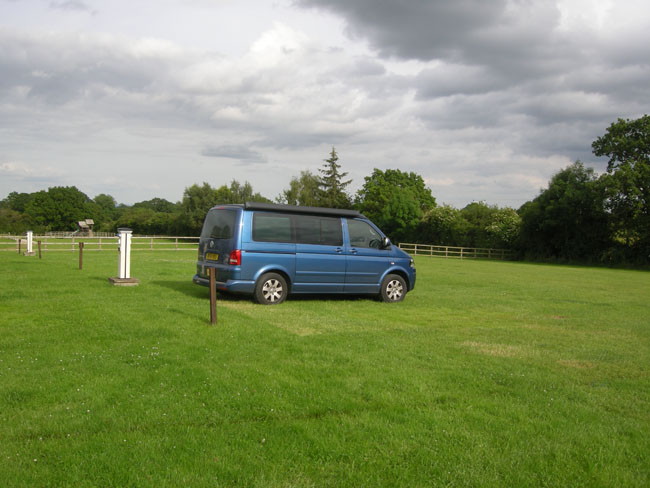 |
| In the morning we headed for York |
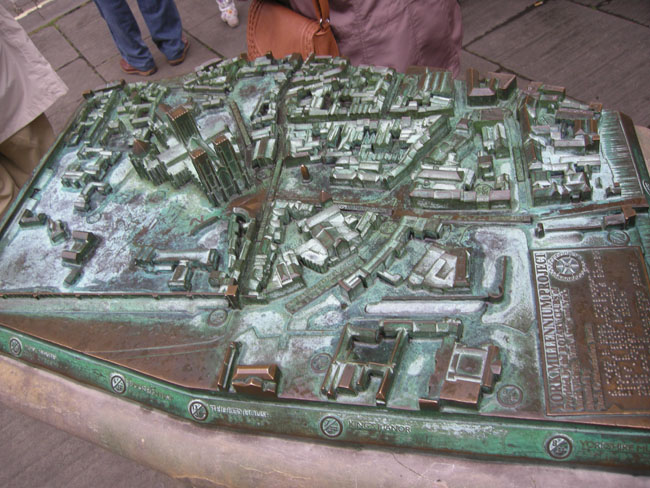 |
| ... which is another walled Cathedral City. |
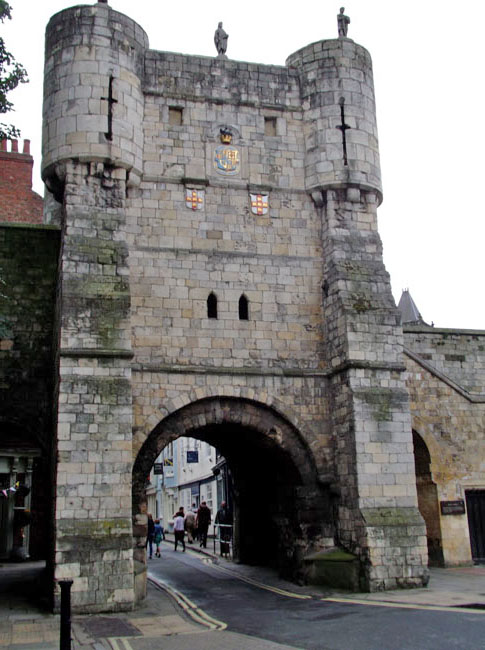 |
| The city wall can be walked along |
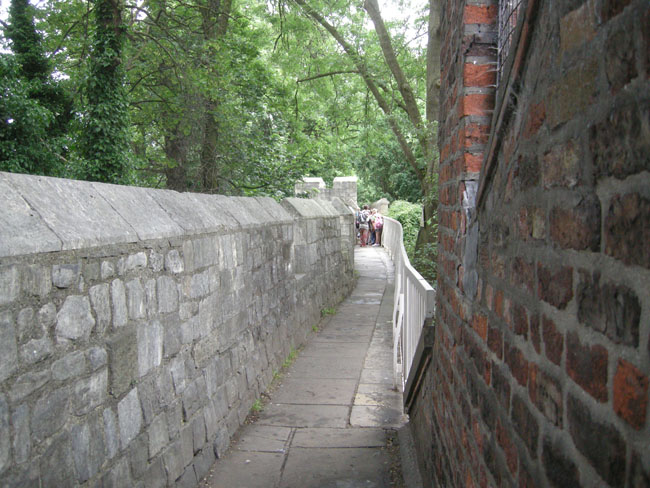 |
York Minster suffered the usual loss of statues and stained glass in the civil war of the 1600s but it is slowly being restored.
Henry VIII did not contribute to its desecration, since it wasn't part of a monastery. |
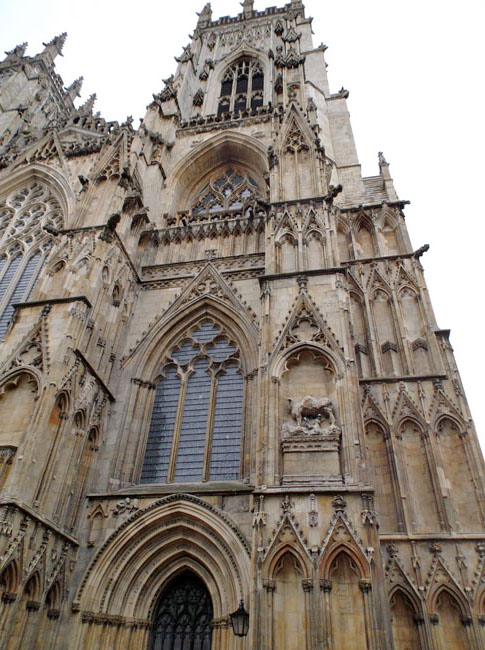 |
| Let's see... we get the usual vaulted archways |
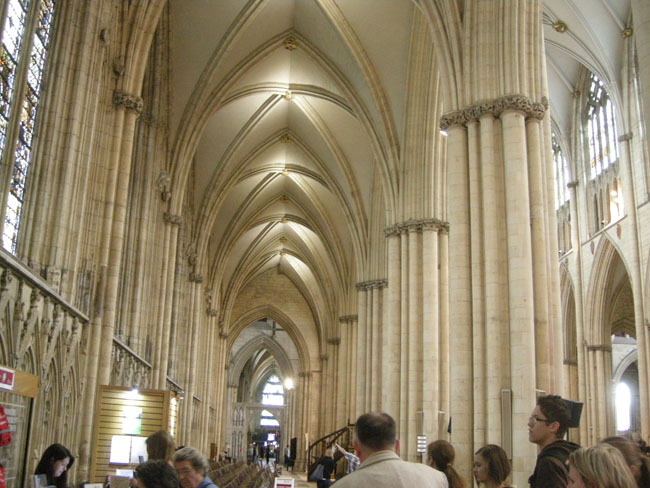 |
| The vast areas of stained glass waaaaaay up there... |
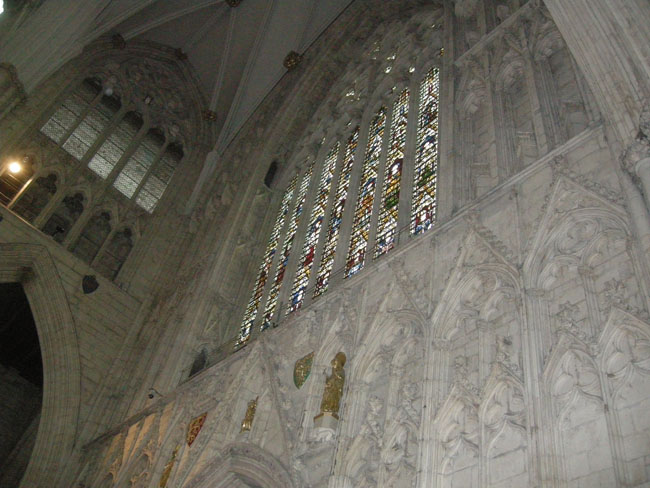 |
| The armies of carved saints and respected figures... |
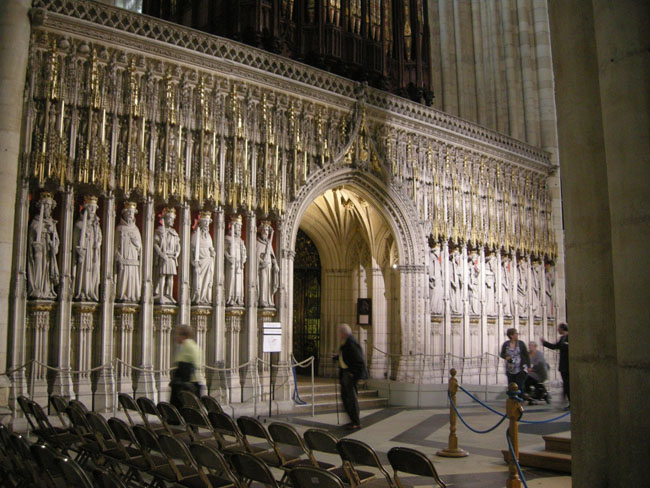 |
| The high towers... |
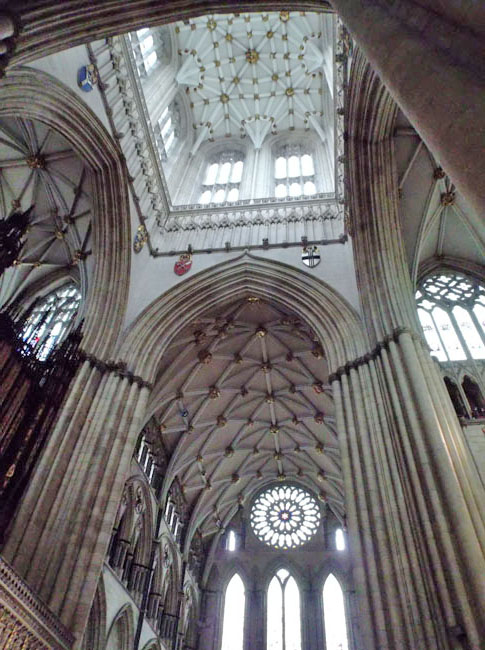 |
| ... and the choir area. But we also find: |
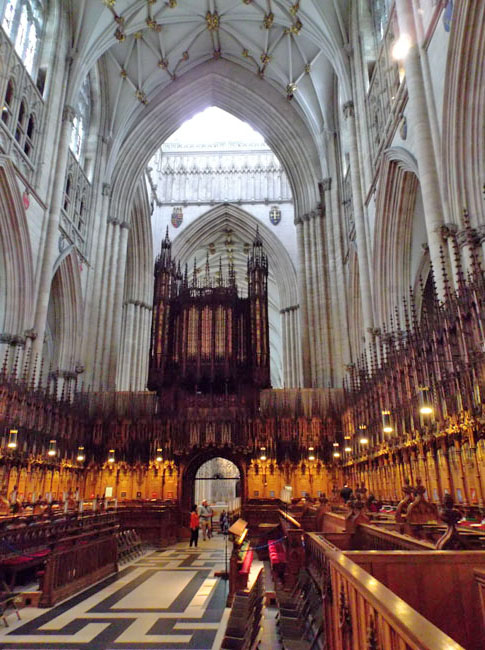 |
| There was a large exhibit on the cathedral's on-going East Window stained glass repair effort: how glass is made, old and new tools, example windows with before and afters etc. |
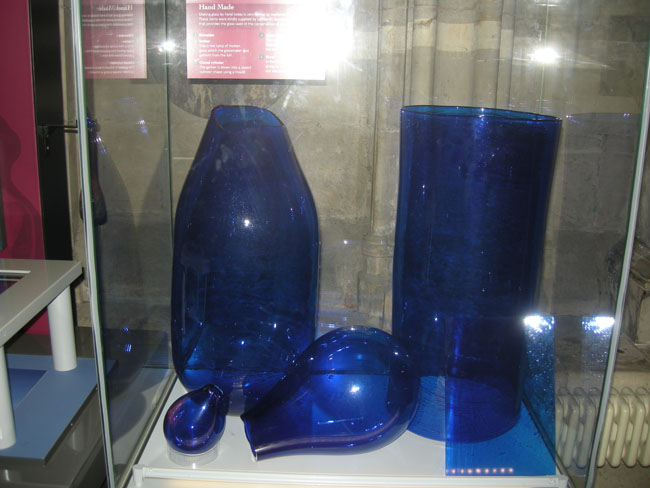 |
| |
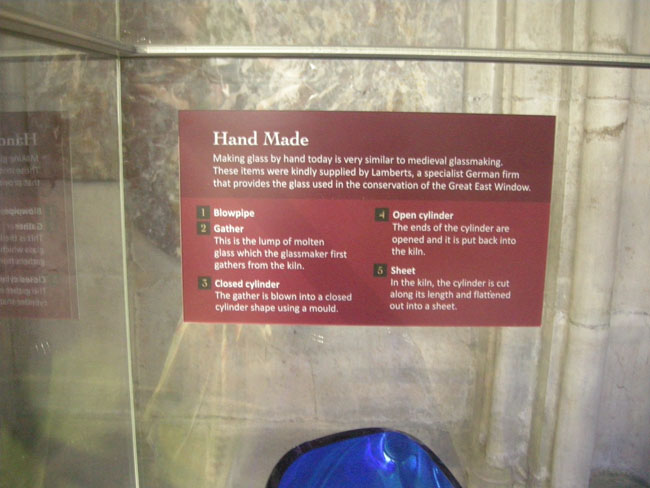 |
| |
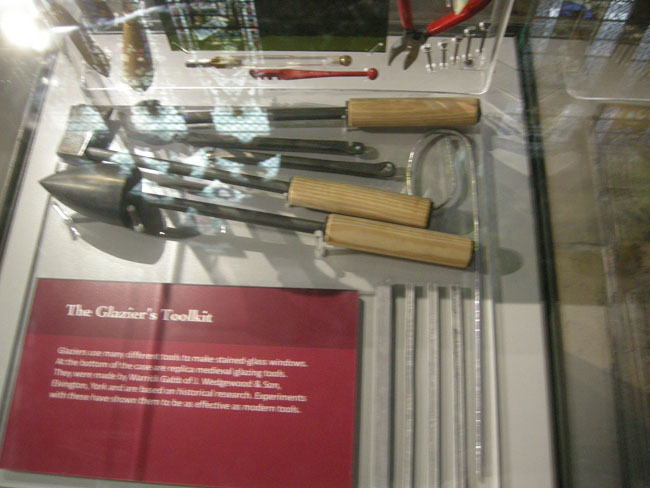 |
| One of the older built-from-shards windows |
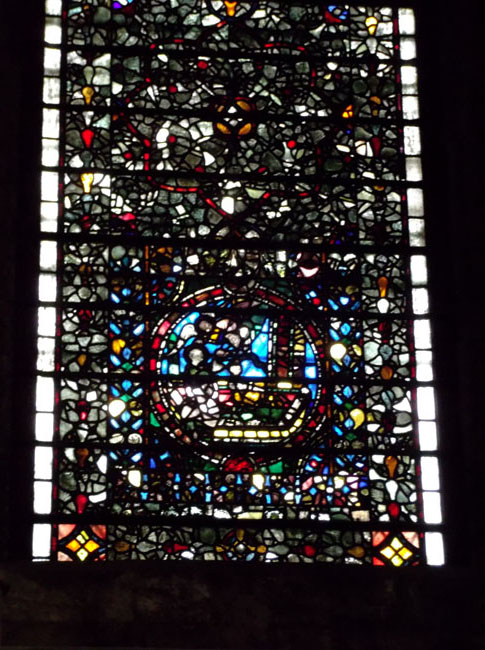 |
And one of the recently repaired panes.
Dick was fascinated by finally being able get nose-to-glass with a few of the medieval windows in the display. A steady stream of the restored windows are in a rotating display: workshop to display to back up to their place in the sun, with the next restored window taking its place in the display. |
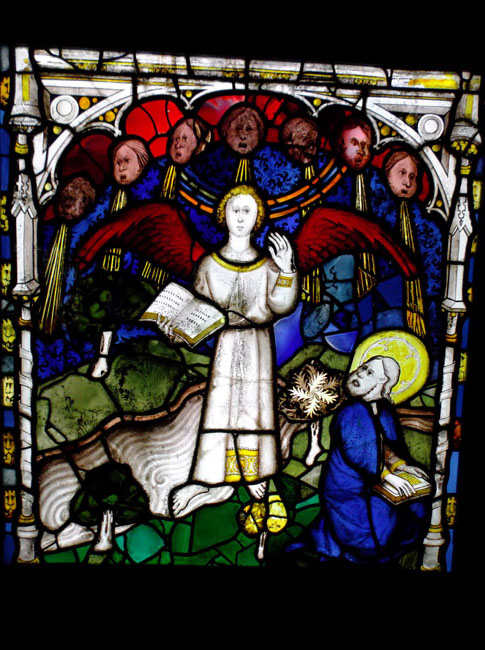 |
| There was also a display of stoneworking techniques |
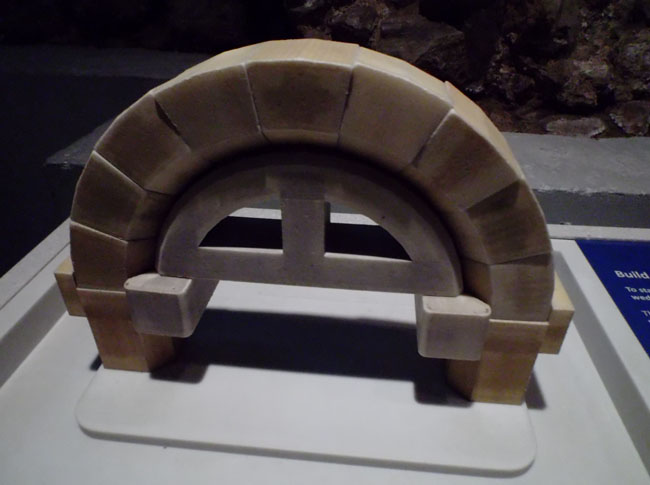 |
| Then we toured the Treasury where the craftsmanship of most of the objects was superb. |
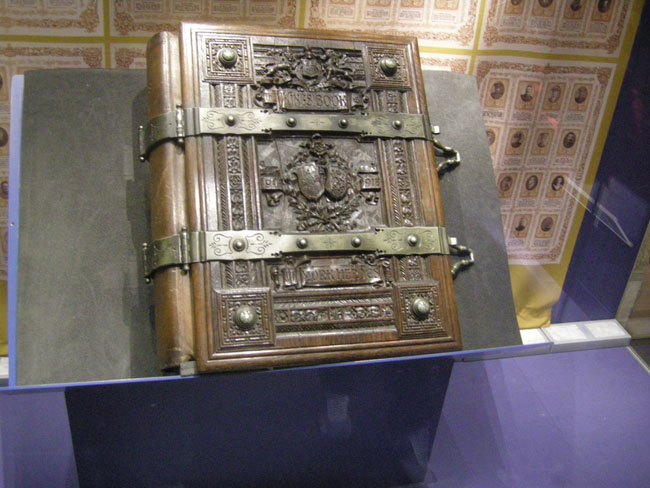 |
| There was also a display of roman artifacts: in fixing the foundation it was discovered that the cathedral was built on top of roman ruins. |
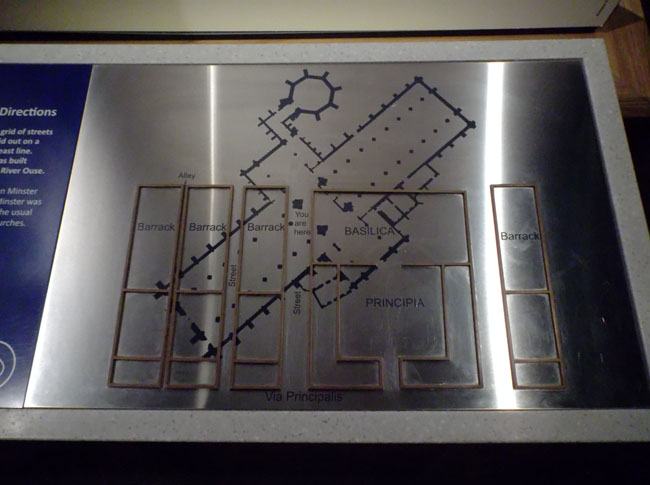 |
| The tour of the basement showed some of them |
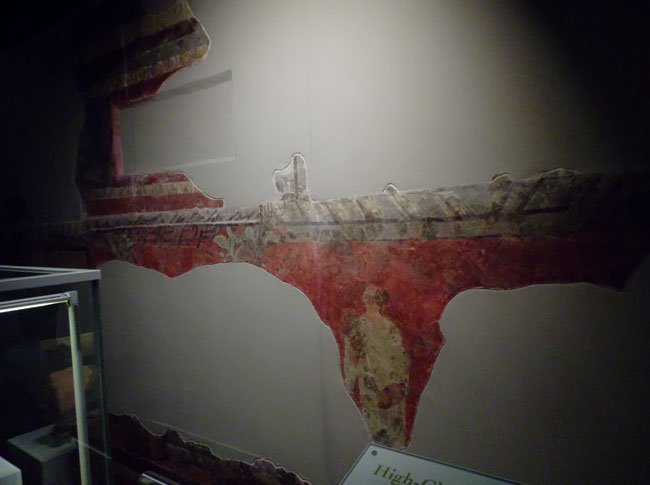 |
| |
|
| Back upstairs we marveled at the vaulted roof of the chapter house |
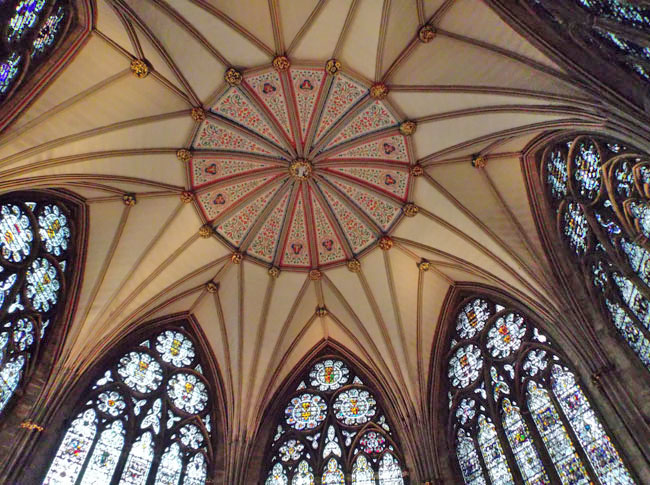 |
| and the size of some of the organ pipes |
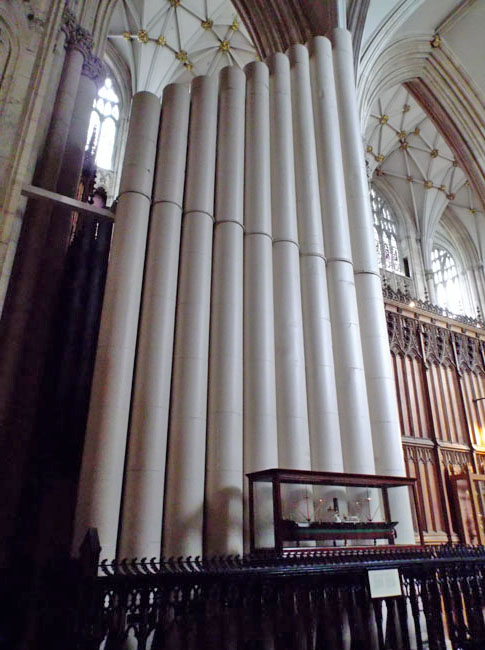 |
| And smiled at the semaphore saints (a 2004 installation, "without mouths to speak they can communicate using symbols"). |
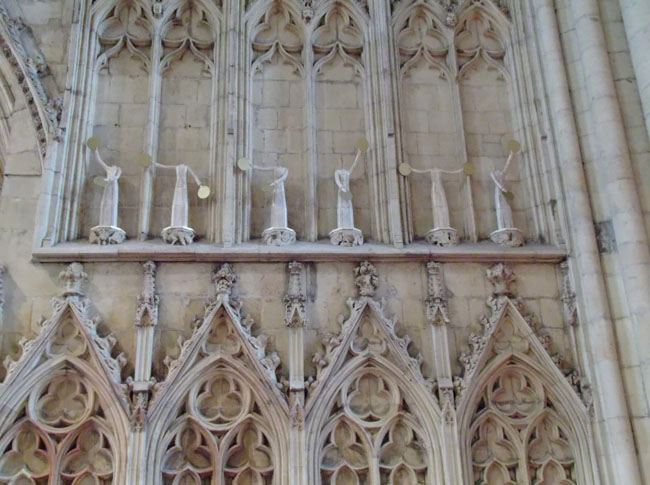 |
| An aid to decypherment was provided. |
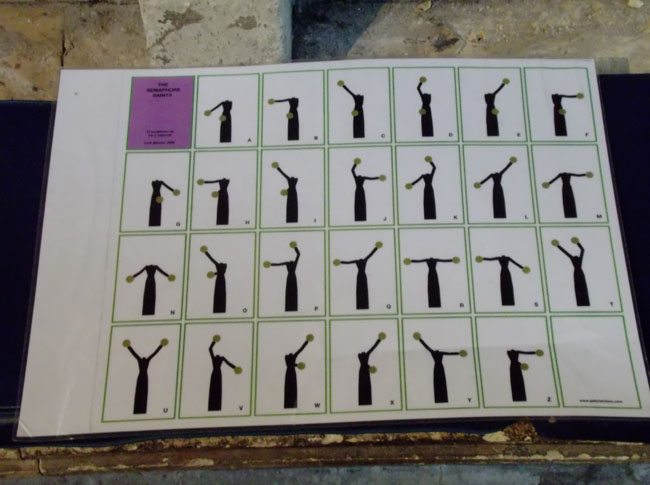 |
| Outside was another Roman connection: a statue to Constantine where his army declared him emperor -- he was in York when he inherited the throne. |
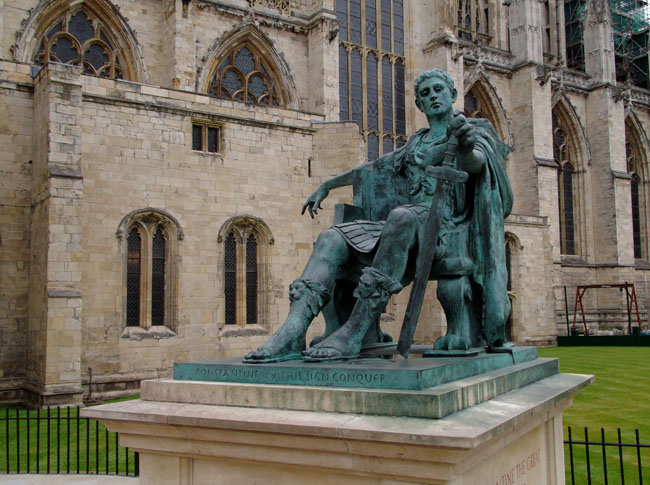 |
| The town had more diverse buildings than Bath or some of the more touristed places we'd been. |
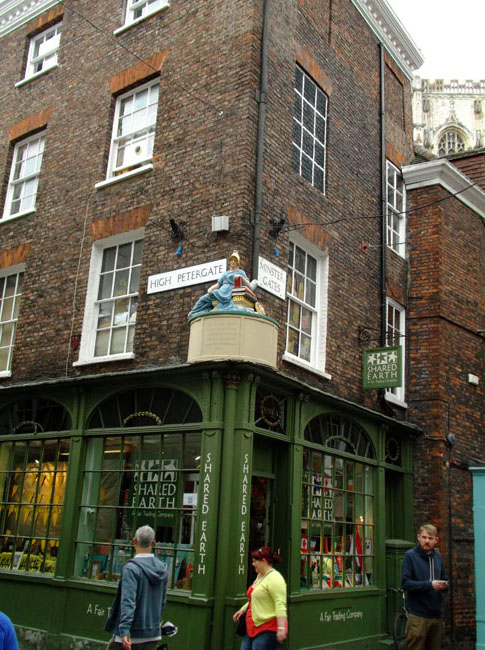 |
| Innovative "floral" decor |
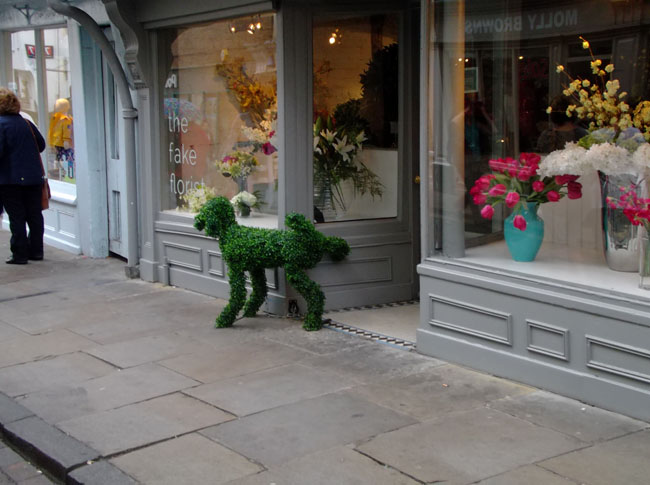 |
A group harmony performance with tourist joining in.
(we're still in York, despite the shop's signage) |
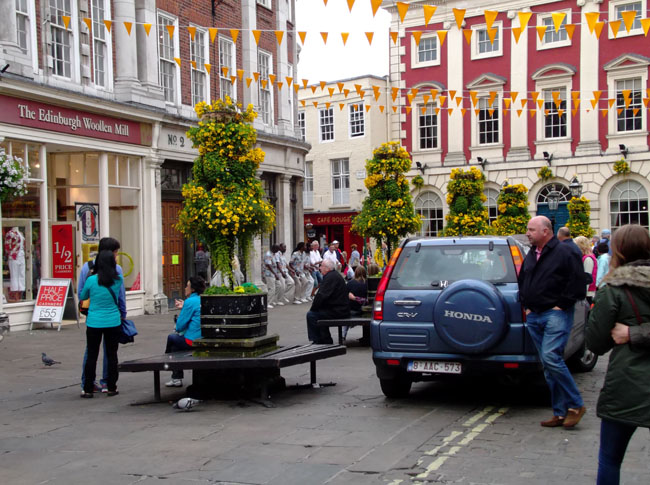 |
Warnings to make us glad to be leaving on July 4th.
Similar signs had been on some of the major North/South Motorways. |
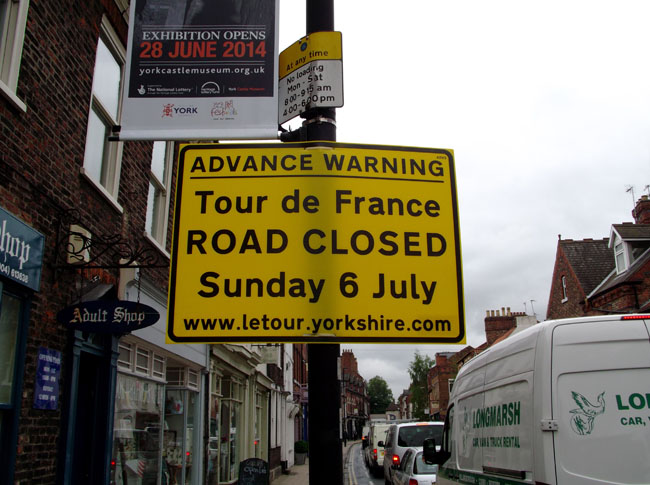 |
| The towns were full of lots of yellow bikes (and unicycles) to celebrate the event |
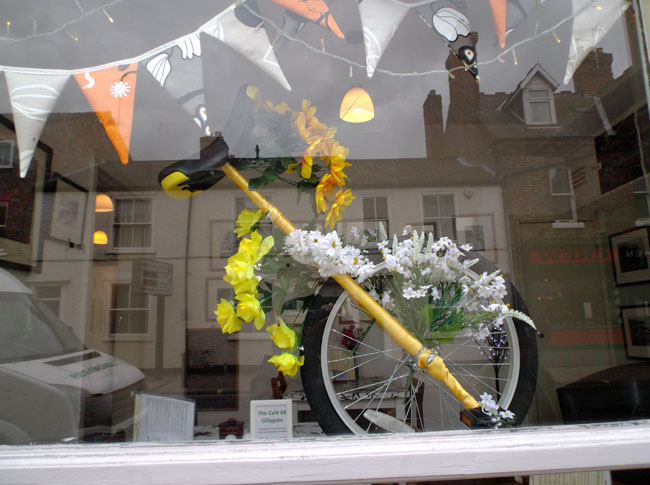 |
| A very British sign as we headed out of town |
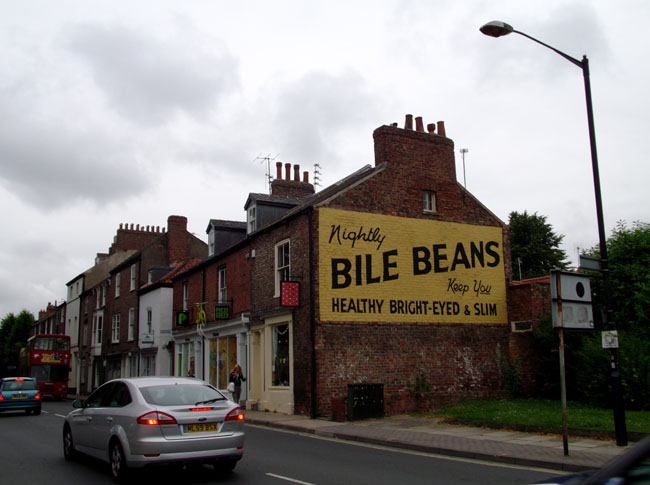 |
From York we headed south on the A1 towards Cambridge, but didn't quite make it. Enroute, highway signs informed us that we were passing through Sherwood Forest (but Dick didn't wake Karen from her warm-in-the-sun nap). At Stamford we detoured to camp for the night.
Tallington Lake's Holiday Park was a water sports paradise: swimming, jet skis, water skiing etc. ... plus a nearby dry ski slope. A ramp covered with a lubricated (by misting water) plastic mesh. Open all year.
(there had been a similar facility with multiple runs covering a hill near Edinburgh) |
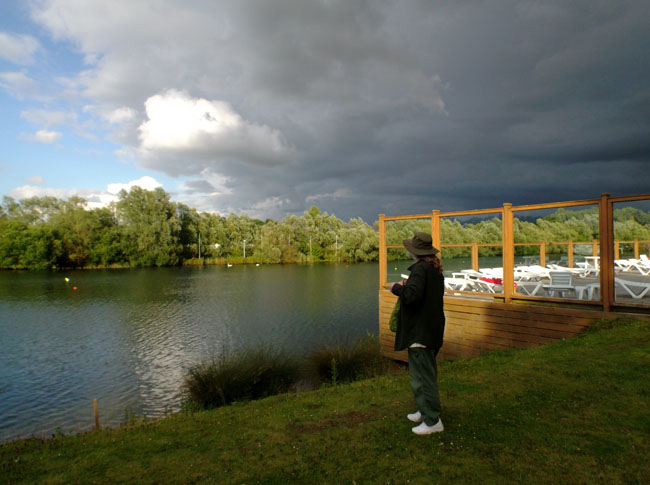 |
| ... with geese (the lake, not the ski slope) |
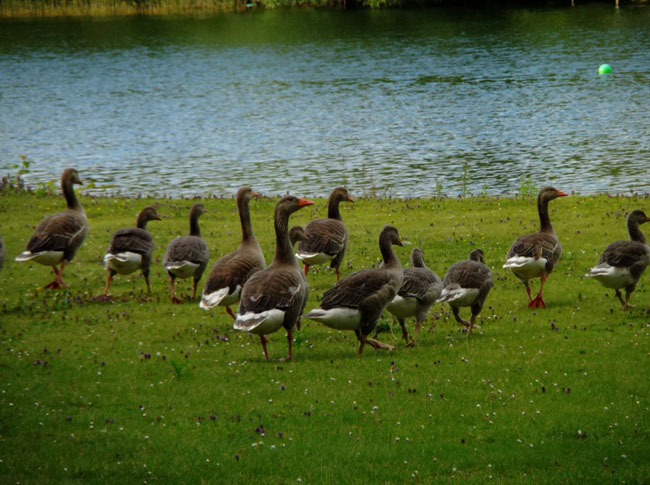 |
| and swans to go along with it |
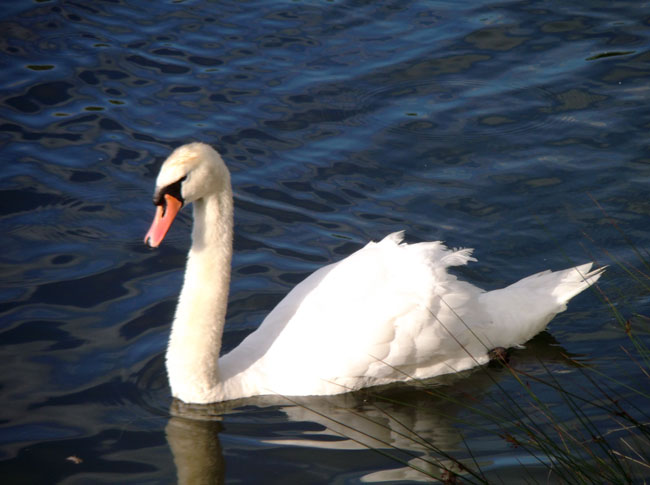 |
Cambridge. First, our GPS/SatNav led us on a merry squiggle through town to reach a parking garage that could handle the VW's height and our planned all-day residency. The squiggle ended with the road narrowing to become a sidewalk with steel bollards (posts) blocking the way 100 feet shy of the goal. A little bit of by-the-map (take 3 rights, then a U-turn) got us into the queue trying to enter the garage. Then the van in front of us hadn't done their homework and stopped just shy of the door since they would not fit the garage's 2.1 meter limit.
Once all that was sorted out, we disembarked and started a day-long walk around town. We passed by the impressive Our Lady and the English Martyrs Catholic Church enroute to... |
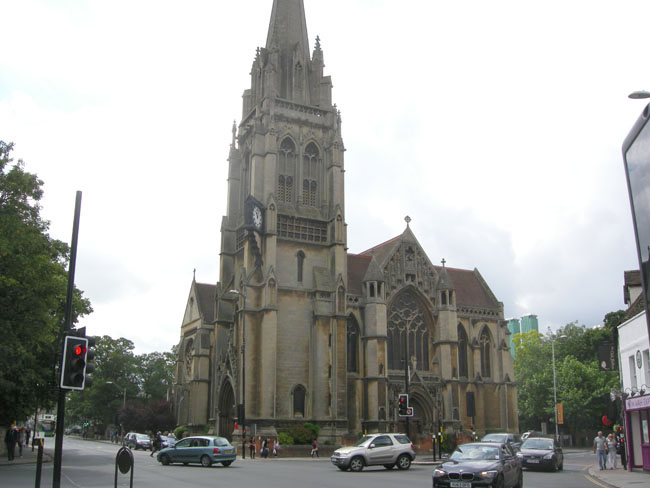 |
| The Cambridge University Botanical Garden |
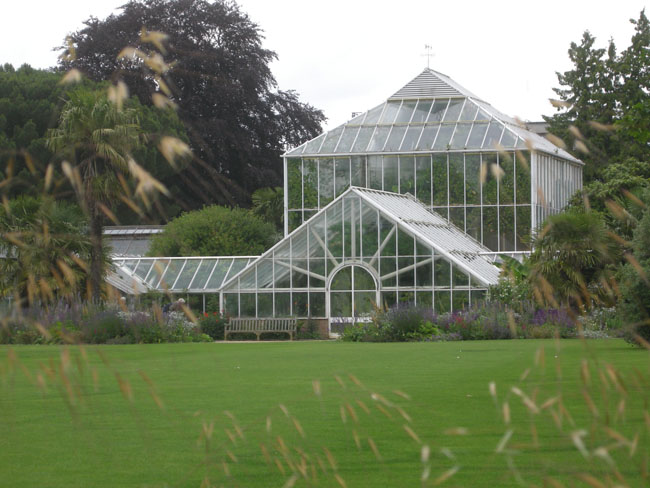 |
| A splendid parkland with fountains ... |
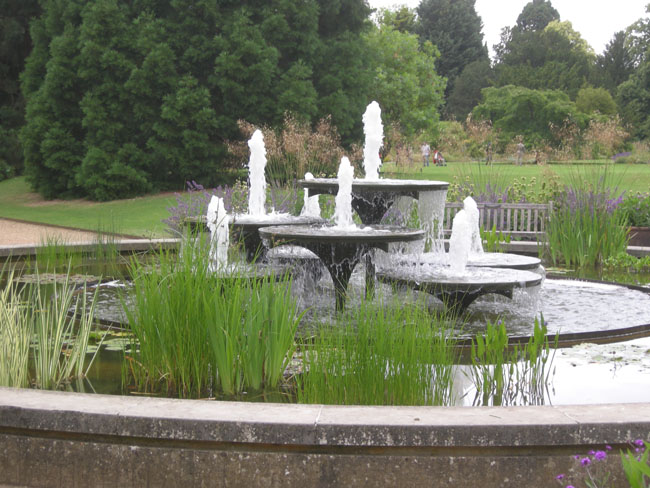 |
| ... plantings arranged by environment, commercial utility, terrain |
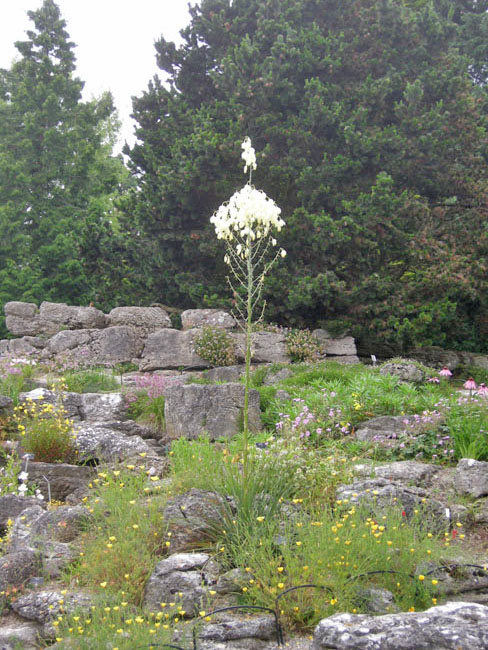 |
| ... and simply pleasurably. |
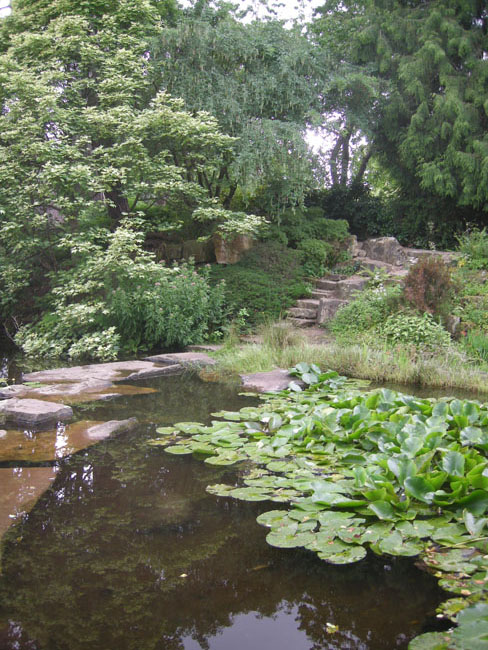 |
| |
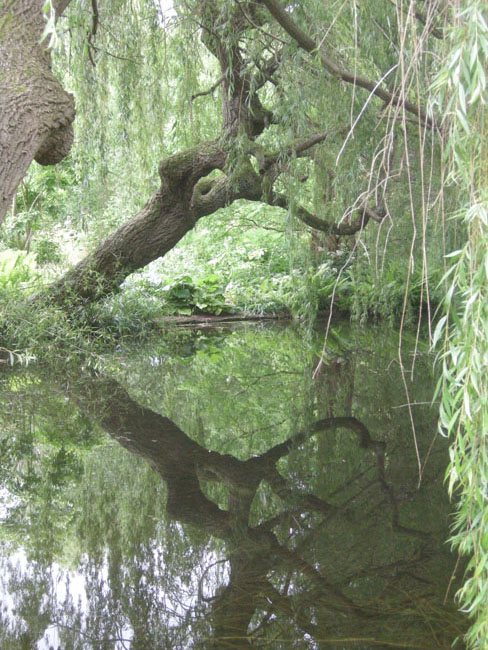 |
This is a wollemi pine (Wollemia nobilis): the latest fossil plant discovery. Until very recently it had only be known by finding it as a (presumed extinct) fossil. Then they were found growing in a secluded steep-side gorge in an Australian rainforest.
(Although it looks like a pine, botanists have assigned to the family Araucariaceae, which went extinct in the northern hemisphere along with the dinosaurs.) |
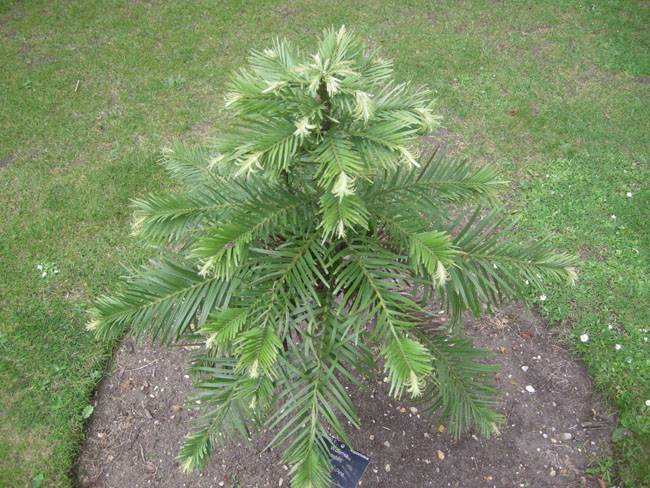 |
Cambridge has a town side and a gown side
... with much of the town servicing the gowns.
(the University owns most of the town)
In 1350 Cambridge had 8 colleges... now it has 31.
We were faced with a torrential downpour as we were preparing to leave the Garden (so we hid in the gift shop for a while). Then we slogged into town on mostly empty streets (such as King's Parade, here) until the rain let up. |
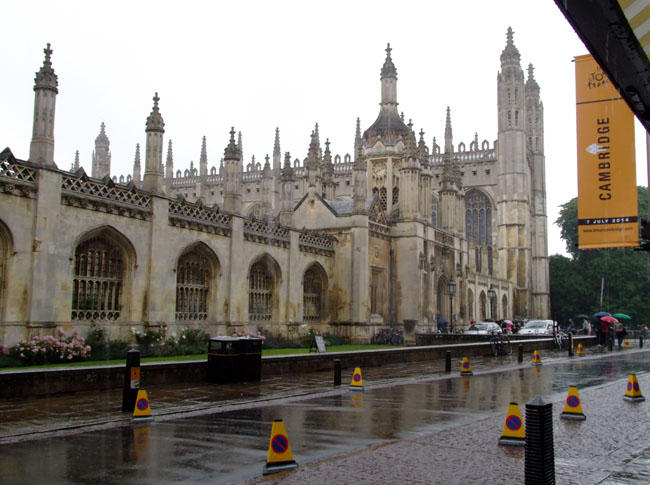 |
| Henry VIII was the third of the Henrys to provide funding for King's college and chapel. |
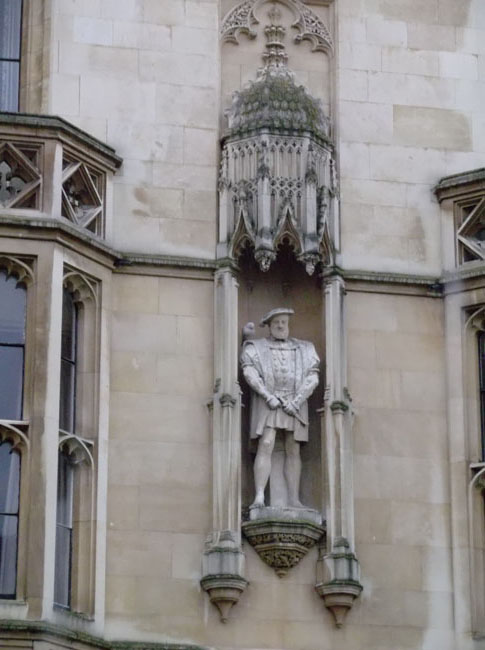 |
| Although the college grounds were closed to tourists due to end-of-term, we were allowed to see the chapel (for a fee) |
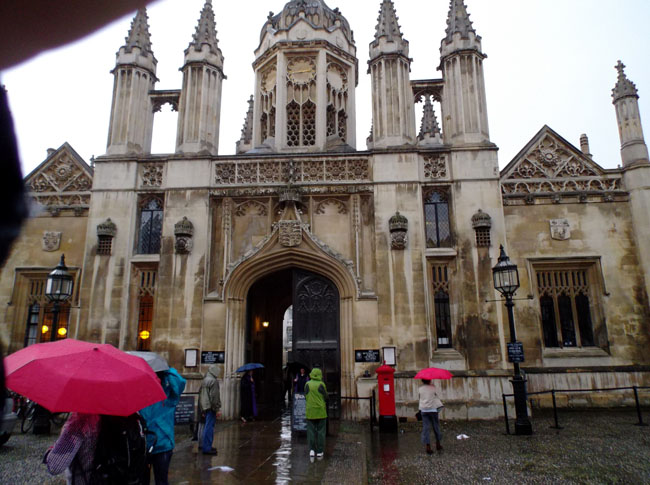 |
The chapel is filled with emblems asserting Henry VII and the Tudor reign.
Left to right: the Tudor Rose (also associated with Henry's wife Elizabeth from York), the Red Dragon reflecting his Welsh heritage, the Leopards had been the royal emblem since William the Conqueror, the Fleur de Lys asserting the English claim on the French throne, the Greyhound as the beast of the Beaufords (Henry's mother's family) and the Portcullis (another Beauford emblem). |
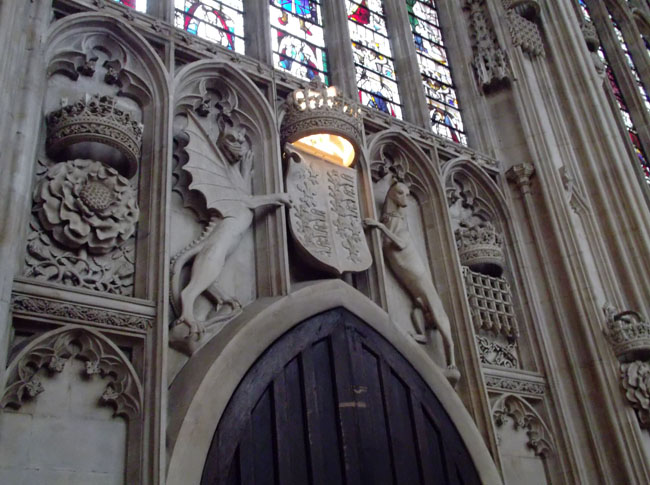 |
Built in the early 15oo's, this is the largest fan-vaulted ceiling in the world...
... and the vaulting's ribs are hollow to lower the weight supported by the walls. |
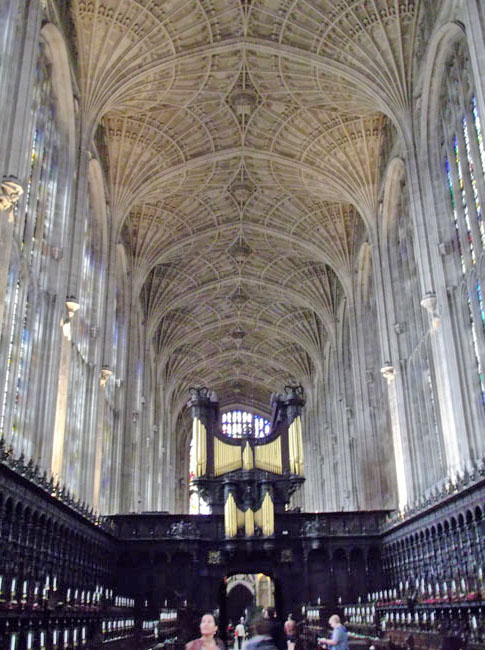 |
| Models and signage in side rooms described the design and construction process (and showed the contracts to the masons). |
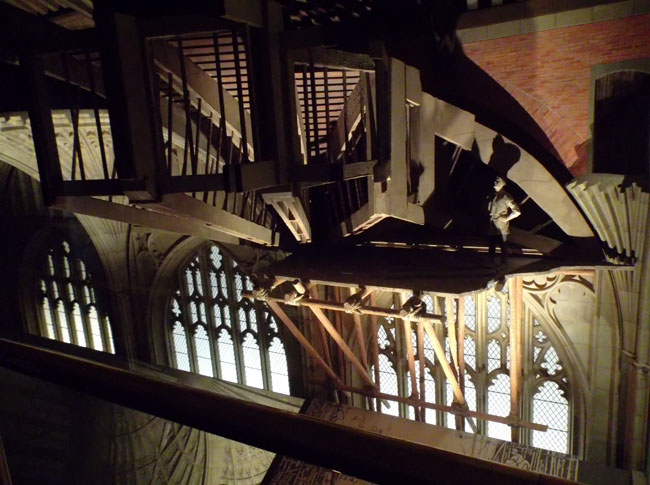 |
| And then there are the windows... unlike so many of the churches we'd visited, King's Chapel's 16th century windows have survived intact through the civil war (even though troops were housed here) since Oliver Cromwell gave instruction that it be spared. He was a Cambridge student. |
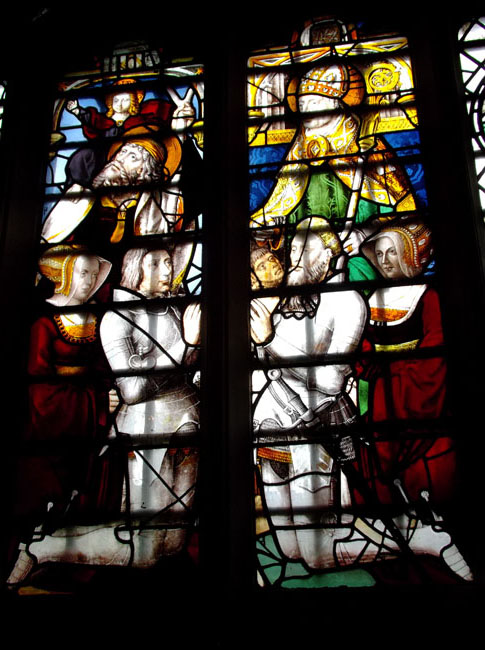 |
| This isn't explaining the iconography... it's describing the technical details of the window's construction, repair and "political corrections" modifications over the centuries. |
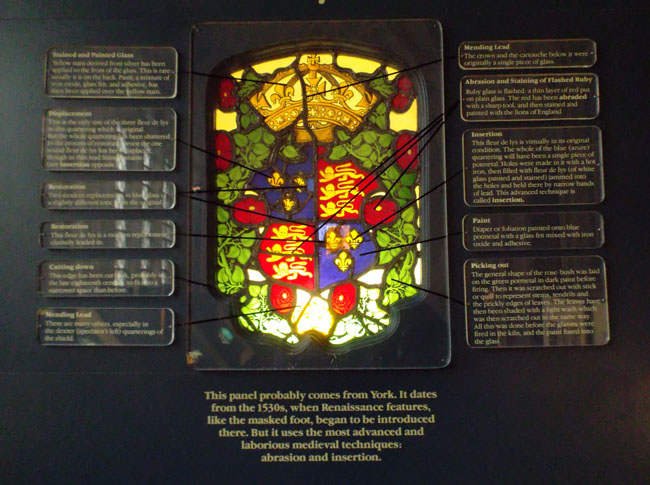 |
All told, it took five kings to complete the chapel.
In this family tree, each is holding the section completed during their reign. |
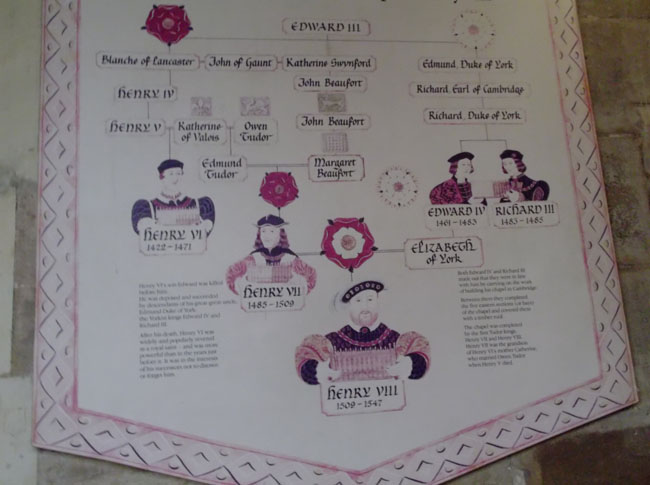 |
| The tools of leaded glasswork have not really changed very much over the centuries. |
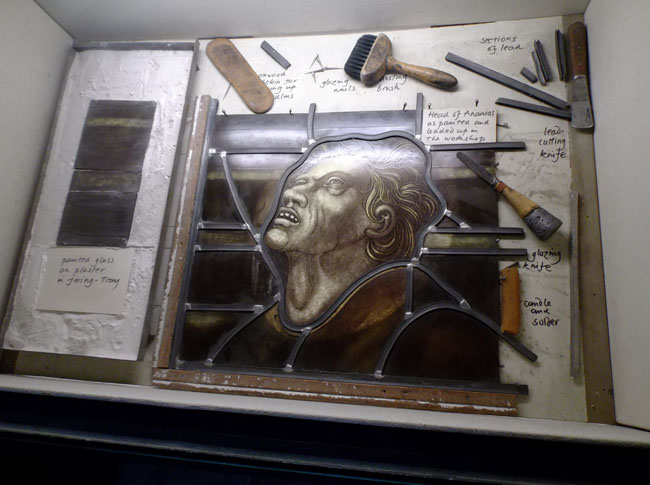 |
| We exited to the main quad to find that the rain had mostly stopped |
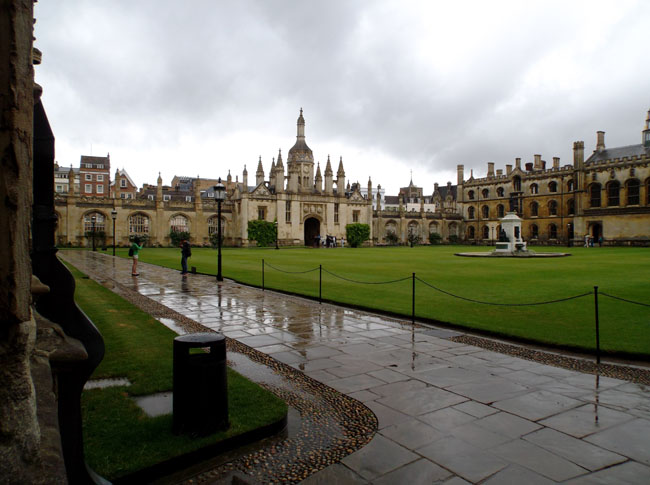 |
Which was a blessing for the gowns that were filling the town, for this was graduation weekend.
King's College graduates were gathering in front of the adjacent Senate House for their graduation ceremonies |
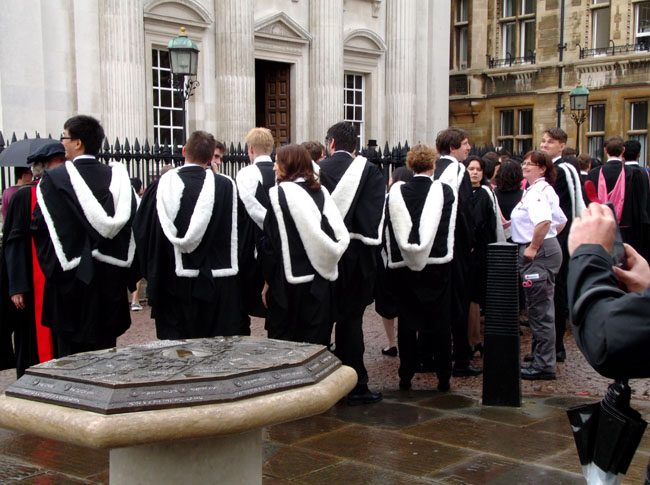 |
Even with the rainy weather there were still people punting on the River Cam.
Yes, we're standing on the Cam Bridge in Cambridge. |
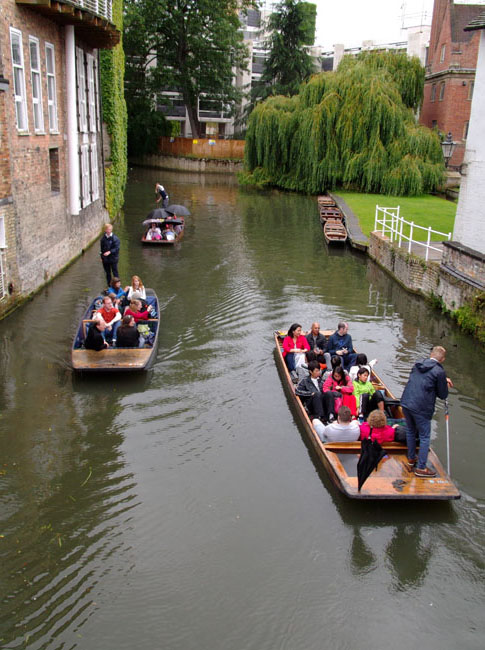 |
Despite graduation, there were spaces available in the Highfield Farm Touring Park 5 miles south of Cambridge.
That night's entertainment featured magpies sealing dog food.
The next morning we hopped onto the M11 and headed south at speed.
We bypassed London and weaved down through the Weald of Kent to reach ... |
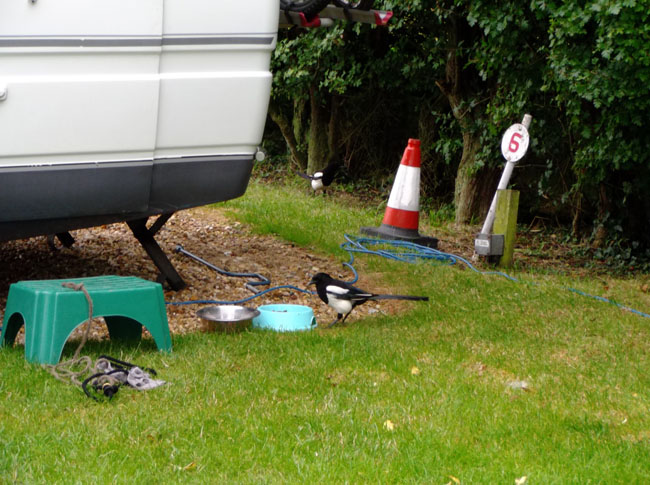 |
The Sissinghurst Castle Gardens, which were packed with plants (and people).
This is the rear of the forecourt, showing the house which flanks the main gate. |
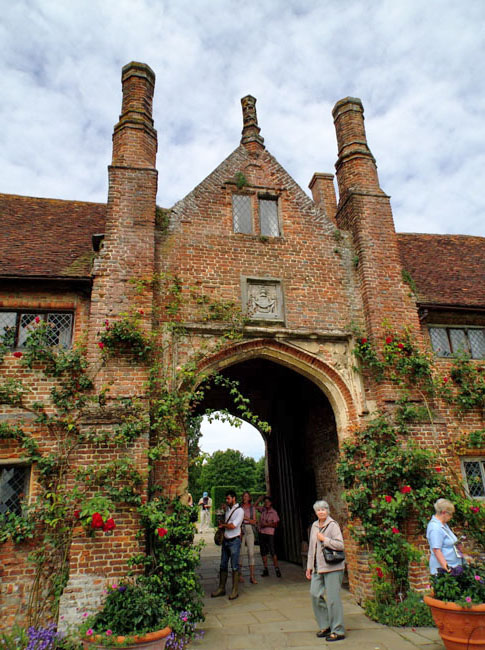 |
| Turning around, we meet the Elizabethan tower |
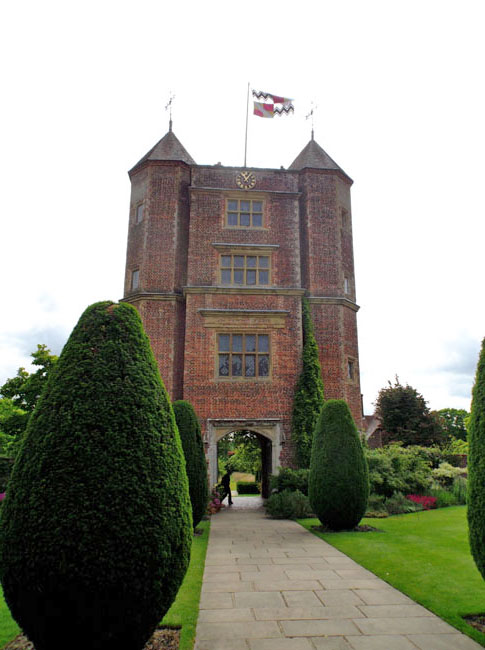 |
| Flanking the tower are the formal gardens which are organized as "rooms".... |
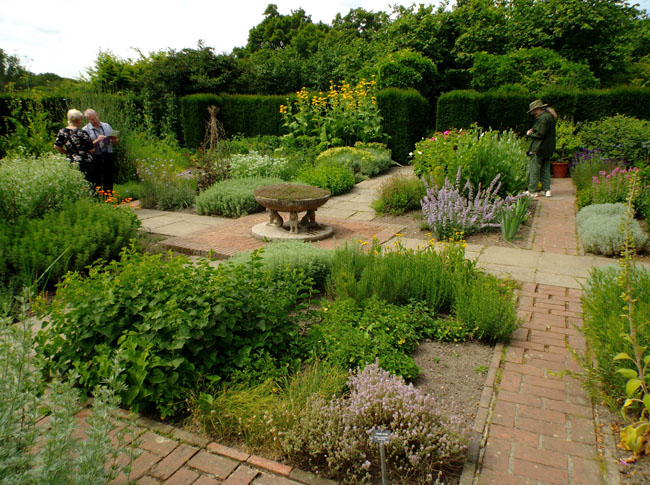 |
| ... this is the Cottage Garden. |
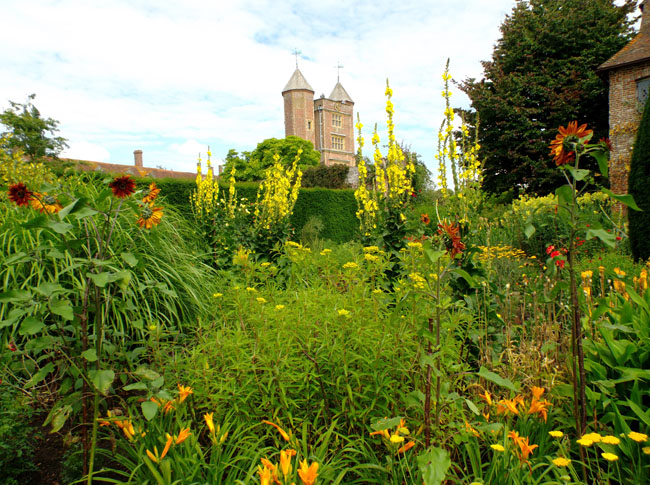 |
| There were some grand old buildings ... this is the adjacent barn |
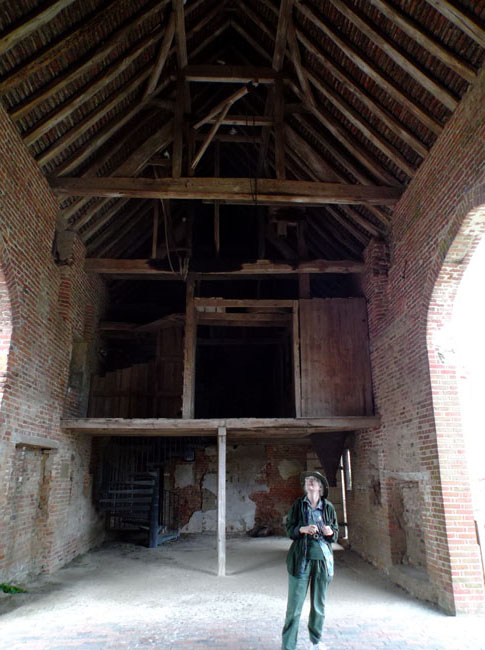 |
| Spiral staircases in the tower led us past rooms serving as mini-museums to the parapets. The view was well worth the climb. |
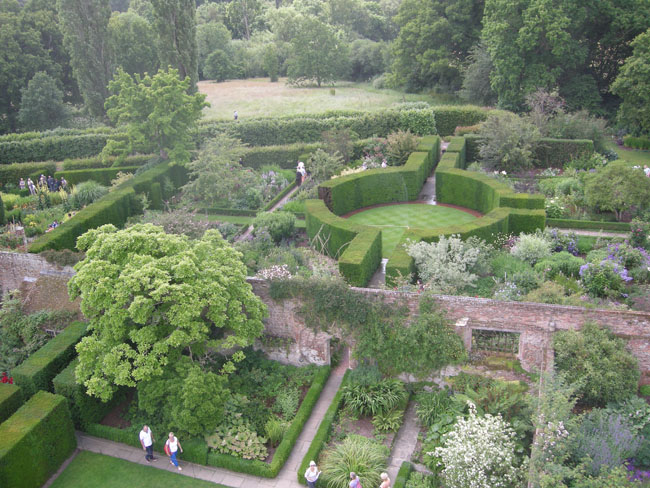 |
| Even some old-fashioned games for the kids |
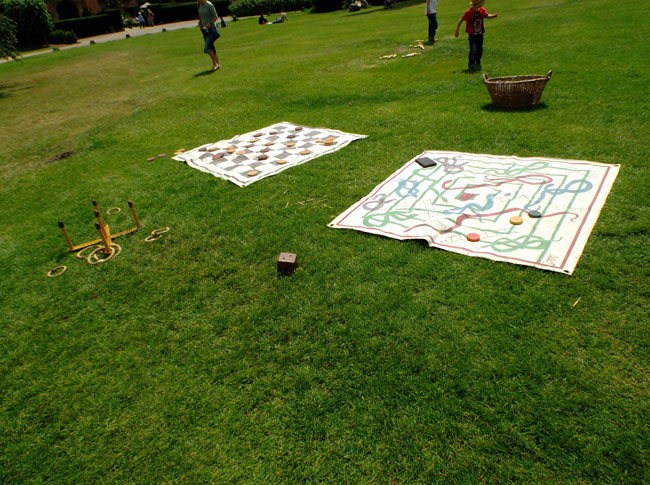 |
| Back on the road, we had to stop for a steam train on the way to the next garden |
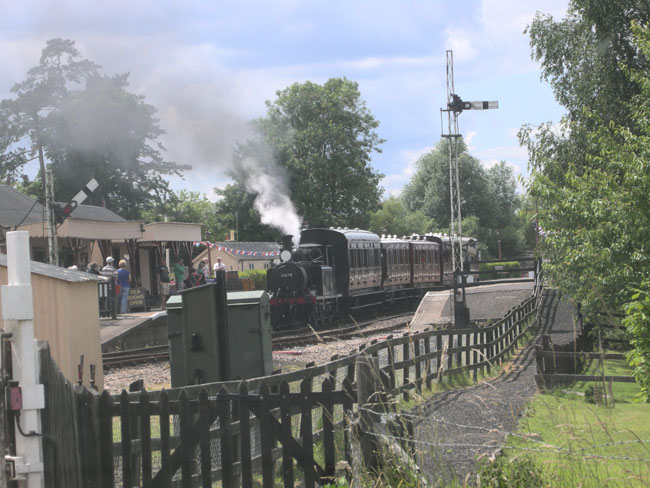 |
Great Dixter was "just around the corner" from Sissinghurst.
(Driver's note: many corners) |
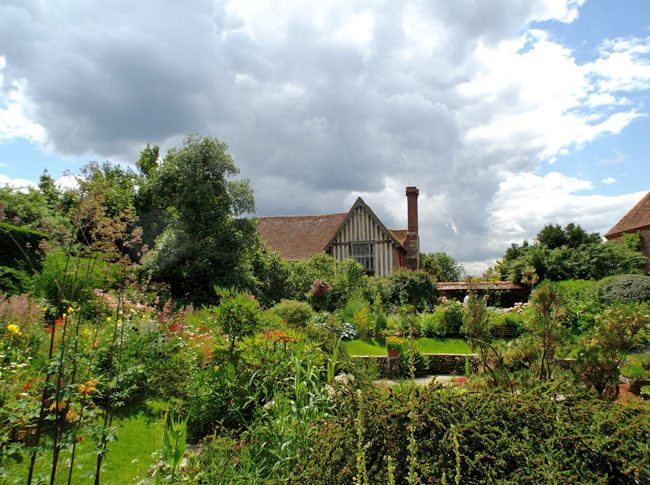 |
| Delicate angel's fishing rods and many other individual flower shots Karen is valiantly not including here decorated the peaceful paths ... |
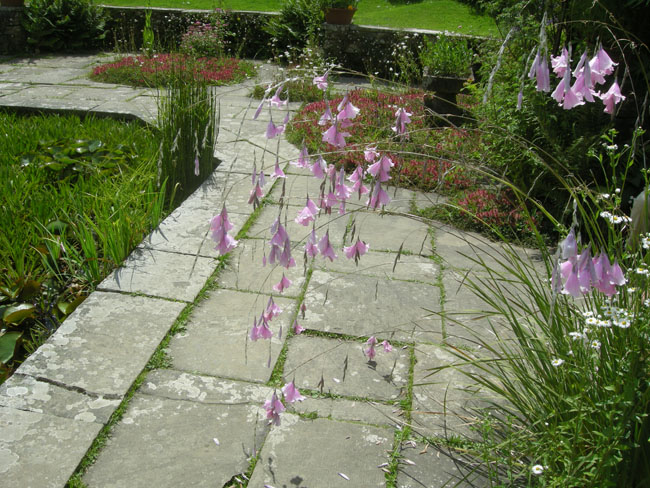 |
| ... and flowering pools -- this was one of Karen's favorite gardens. |
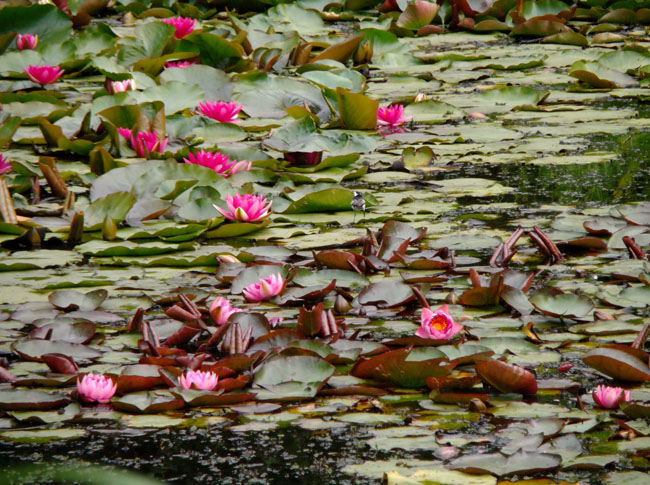 |
| The strange topiary in the back added an amusing note. |
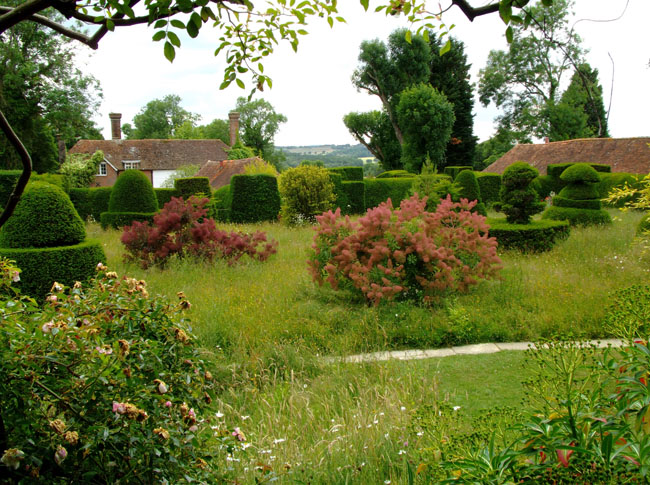 |
| That night we watched the bunnies |
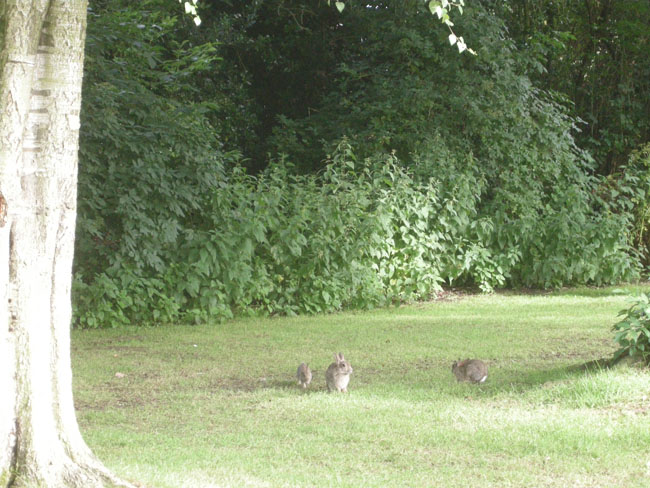 |
| Whilst fortifying ourselves on Scottish Shortbread and planning the next day's route. |
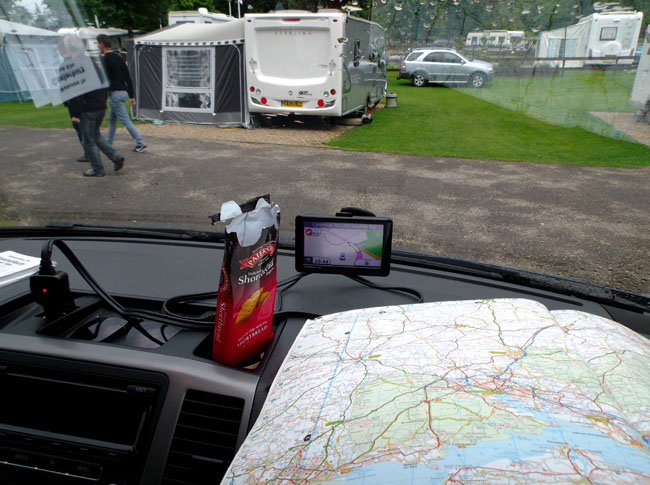 |
| Which began in Canterbury. Christ Church Gate has welcomed pilgrims to the cathedral grounds for centuries. Henry VIII's Tudor Rose has center stage above the arch. |
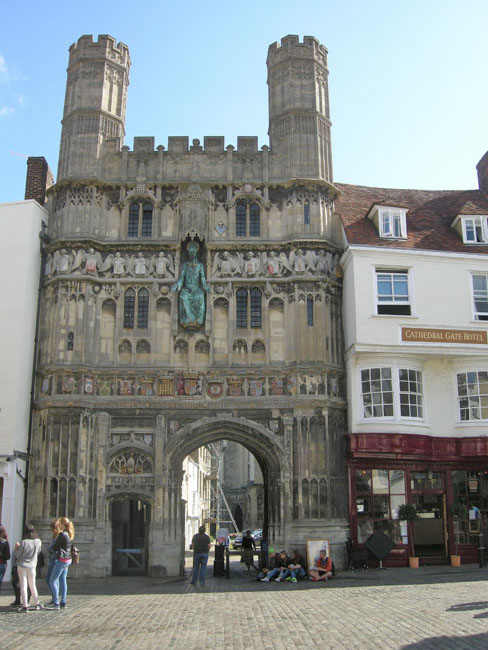 |
| The maps and signage were well done (although we occasionally got lost). We were encouraged to explore (we did). This was the most welcoming of all the grand cathedrals we toured. |
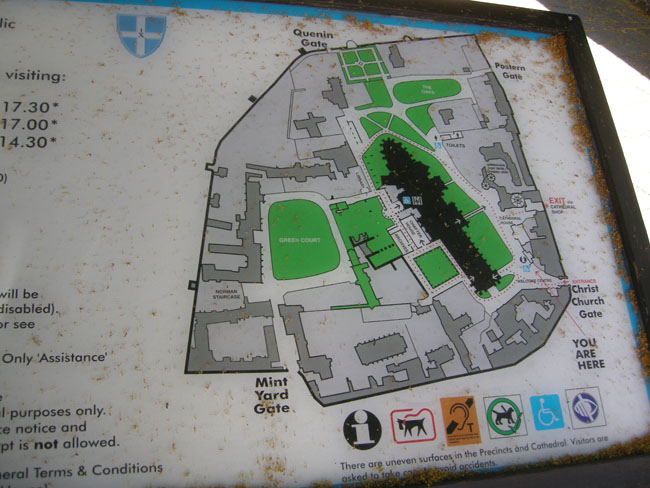 |
| Ground was broken to start this in 597. It was completely rebuilt between 1070 and 1077. It became world famous when Thomas Becket was murdered here in 1170. Pilgrimage soared. The nave was demolished and rebuilt in the 13oo's and another 100 years of construction began in the 15th century to accomodate the crowds. |
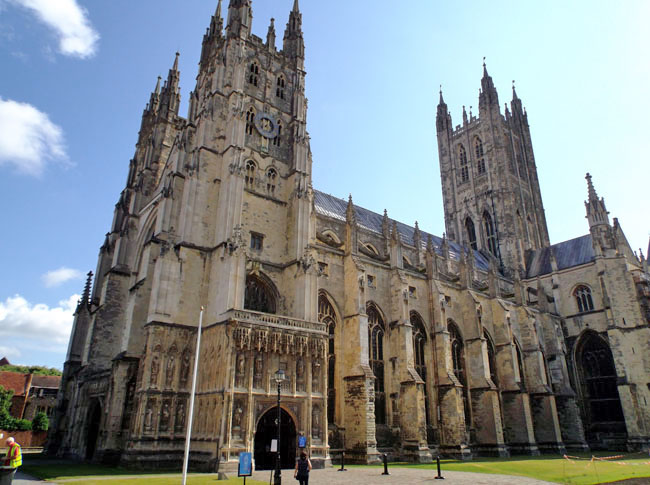 |
Let's see... high walls? Check. Lots of glass? Check. Vaulted arched ceiling? Check.
Welcome to another example of Perpendicular Gothic (thanks to the nave rebuild). |
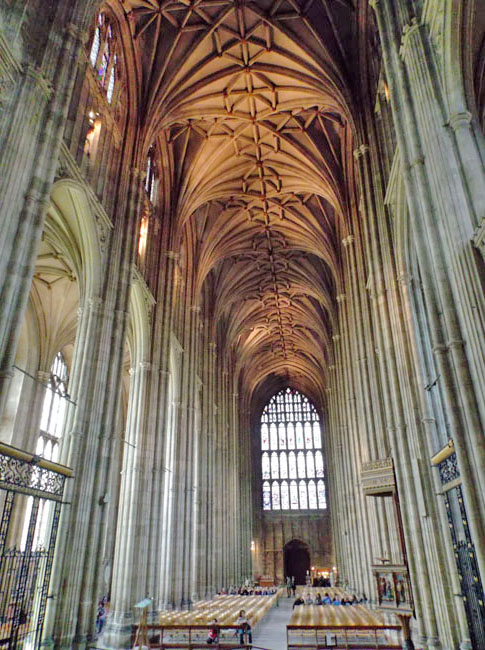 |
| Colored fan vaulting. |
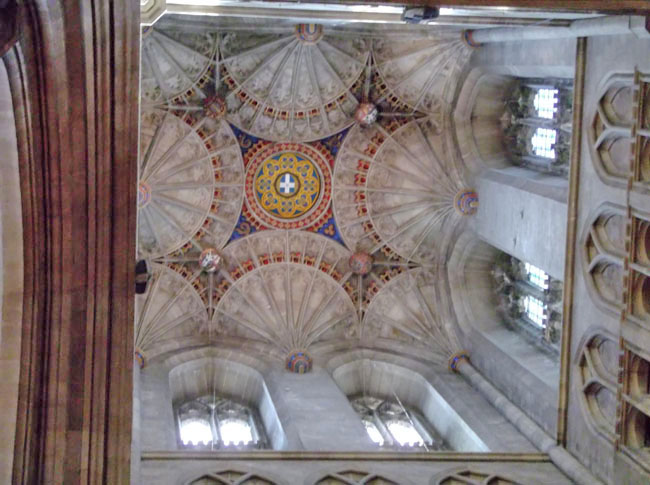 |
| Many of the windows were restored |
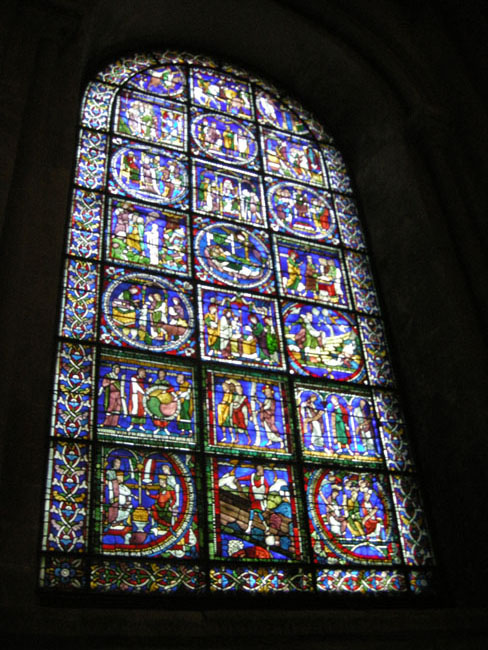 |
| Some were in process |
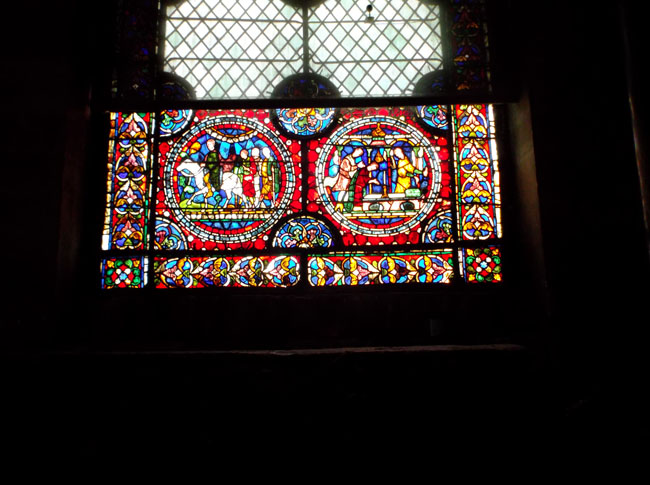 |
| And a few were entirely new work |
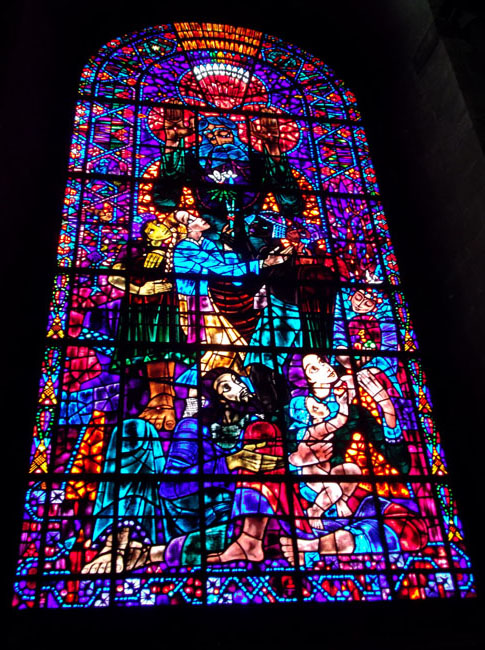 |
| Lots of glass means lots of light. |
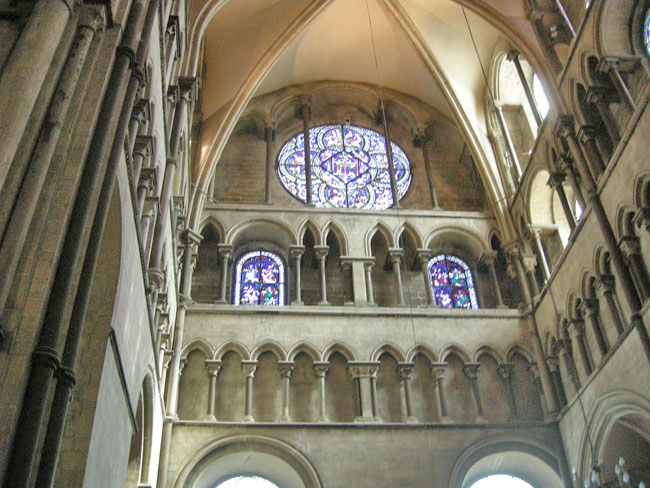 |
Karen was impressed by the baptismal font.
(and, truth be told, Dick's never really fully trusted the winching mechanisms that supports the covers) |
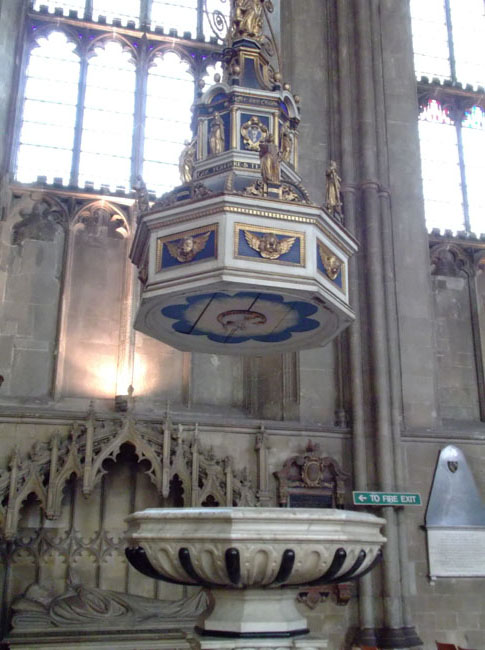 |
| The usual collection of past archbishops |
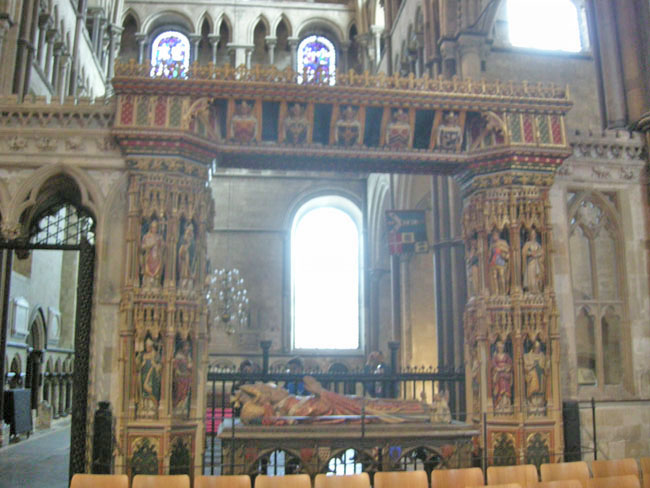 |
| Dedicated side chapels. |
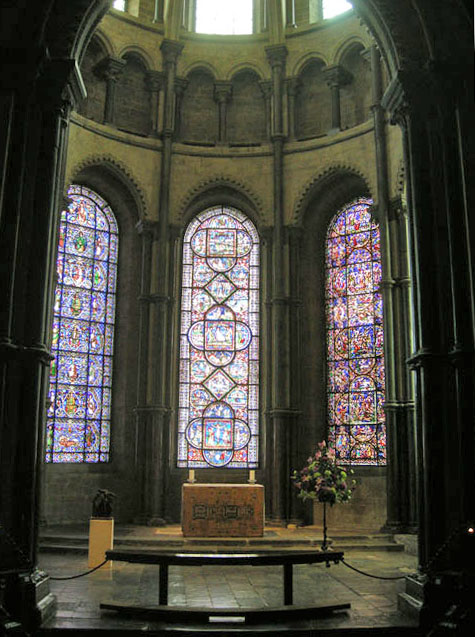 |
| Sculpted wood and stone. |
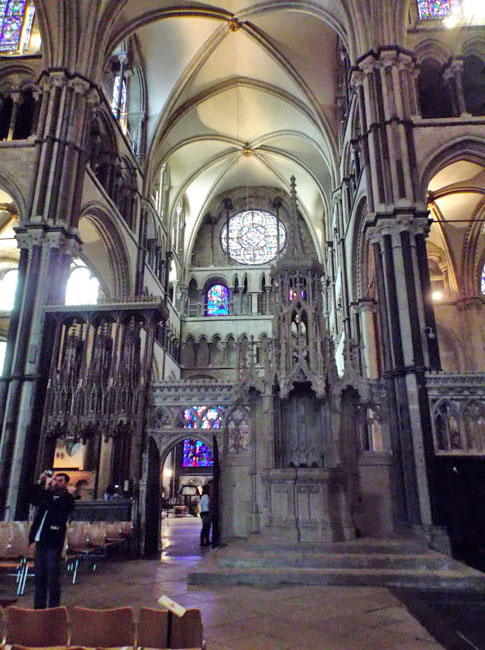 |
| Karen did find the custom of burying people beneath the church floor a bit unfamiliar but understandable. |
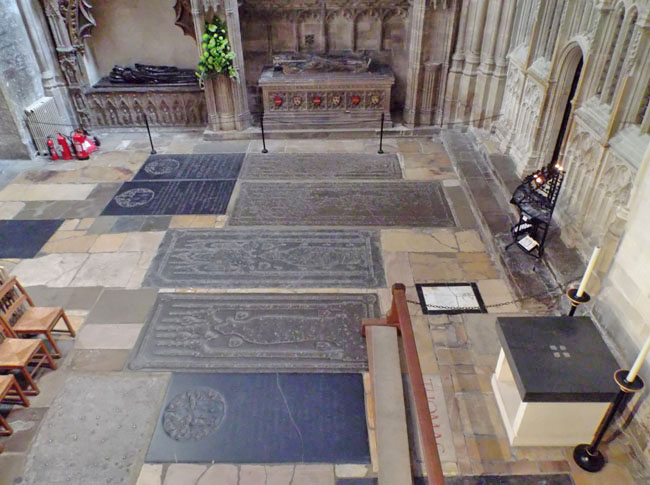 |
| Once it got past the planning commission, a shrine existed for Thomas Becket (and miracles were performed) for the first 300 years after his death. Henry VIII took his usual action. |
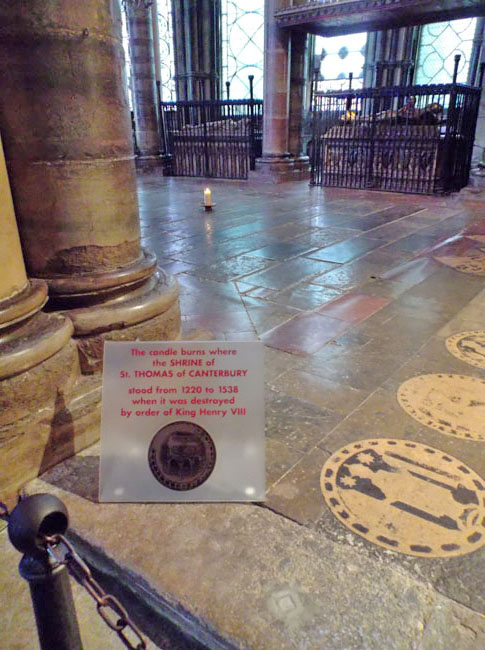 |
Edward Plantagenet, the "Black Prince" (died 1376)
(digging too deeply into any of the honored dead can yield puzzles: Edward was the first Prince of Wales to die before his father (Edward III), so he never assumed the throne (his son did, becoming Richard II). It's uncertain if the title "Black Prince" was ever used while he was alive, and even whether or not it was because of his occasional use of a black shield (with three ostrich featers) or as a condemnation of his brutal use of scorched earth techniques in battles in France. The first surviving written record of the use was nearly 200 years after his death.)
|
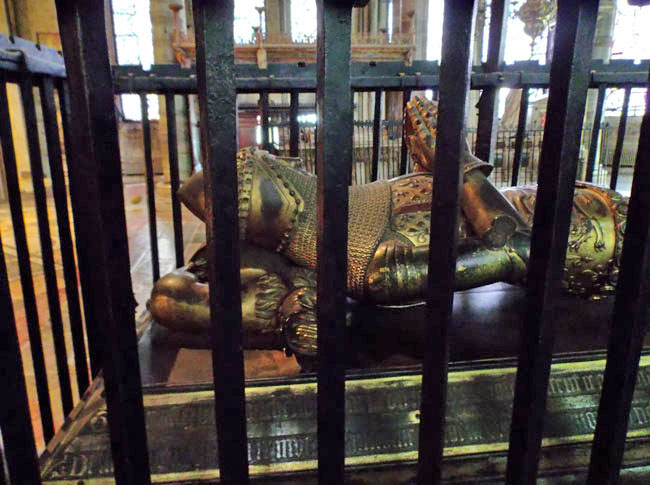 |
| Then we wandered the outside cloisters ... |
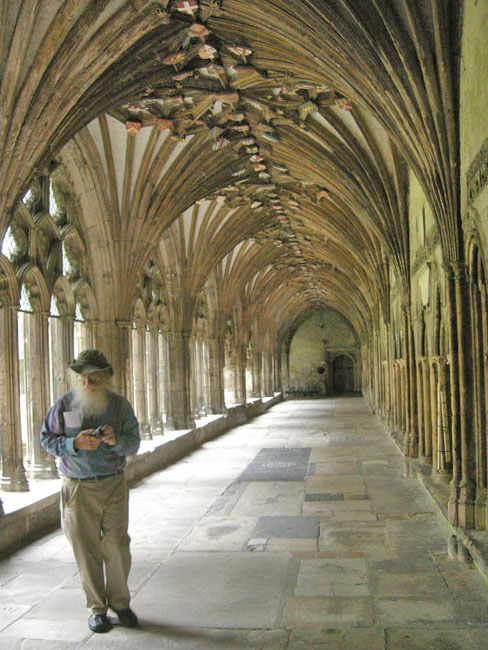 |
| ... admiring the heraldry in the vaulting. |
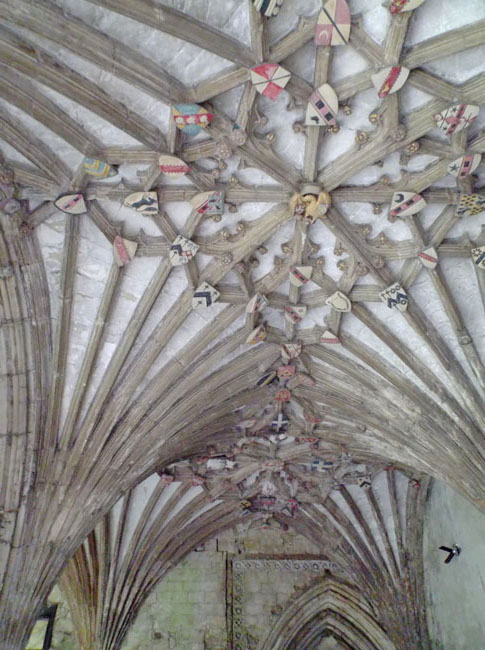 |
| We had a wonderful lunch in a building that was built in 1500, and had been host to a group of French weavers fleeing religious persecution. |
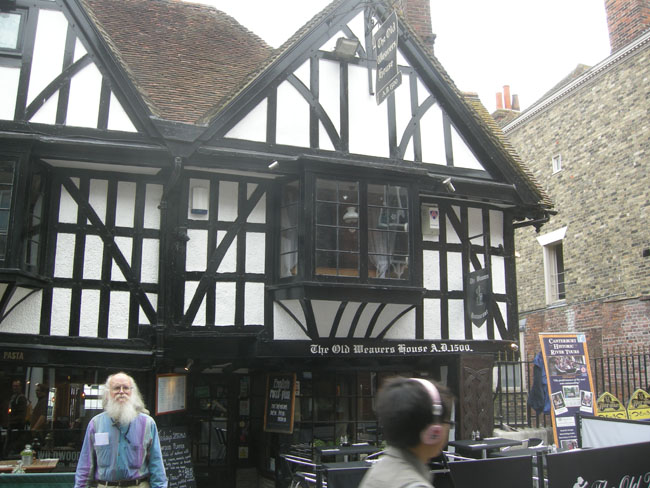 |
| It was right on one of the parallel branches of the Stour River. |
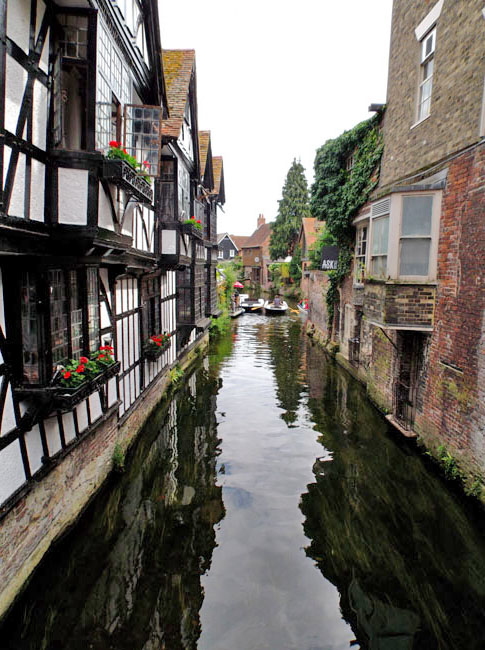 |
| The city's West Gate, built in 1380. |
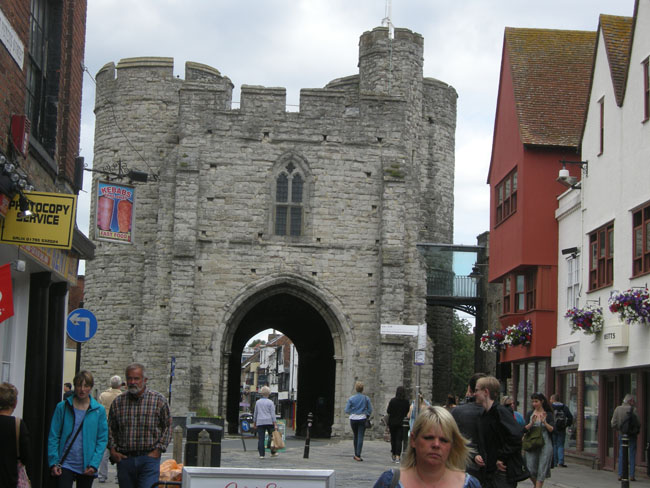 |
| We could (and did) climb to walk the wall around half of the old city. Once up there we could look down into a large park called the Dane John. |
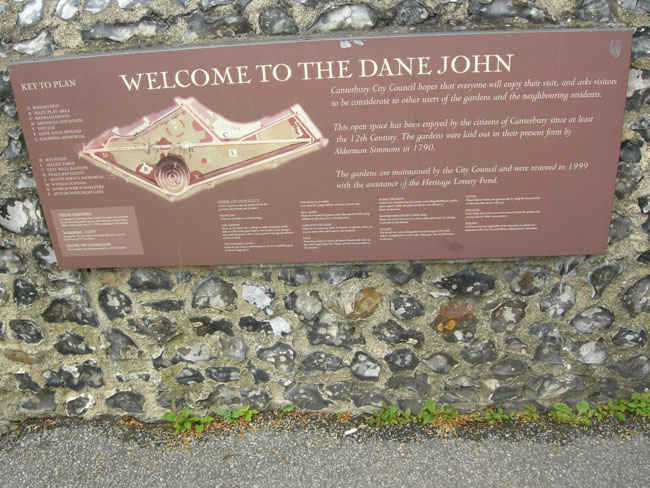 |
| With a delightful fort/maze for kids. |
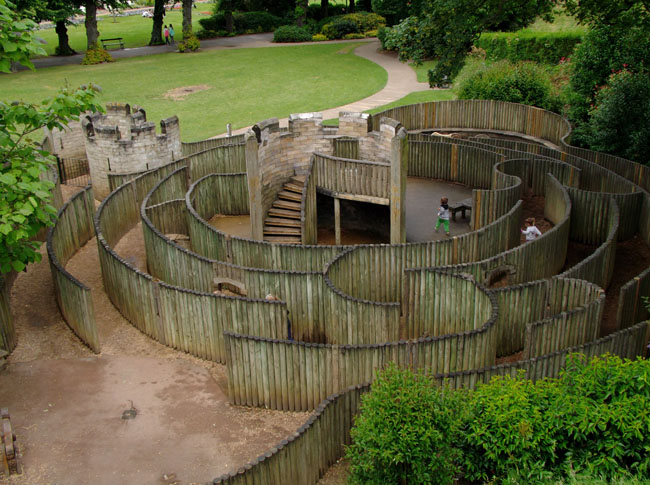 |
| The wall was been restored several times since the first wall and gates built by the Romans. |
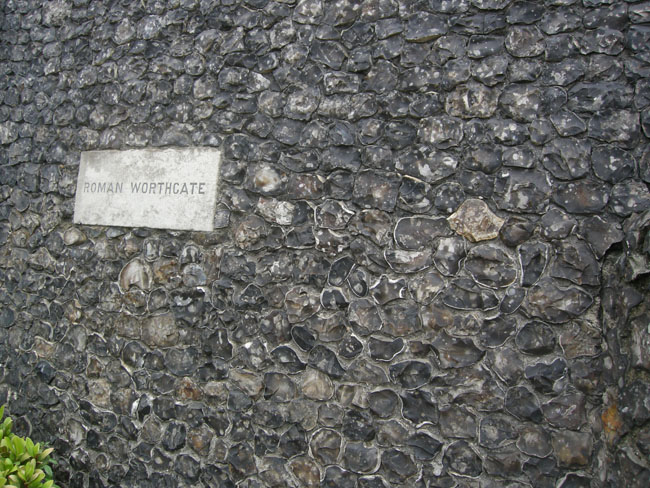 |
| The one there now is flint set in some sort of mortar, |
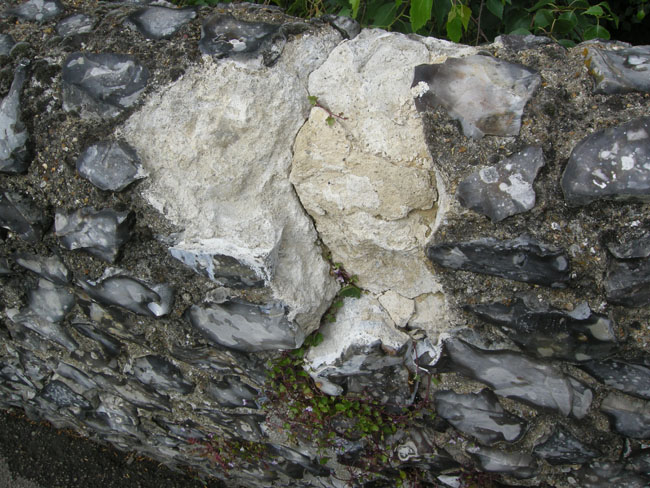 |
| Continuing our after-lunch promenade around the city to return to the VW. |
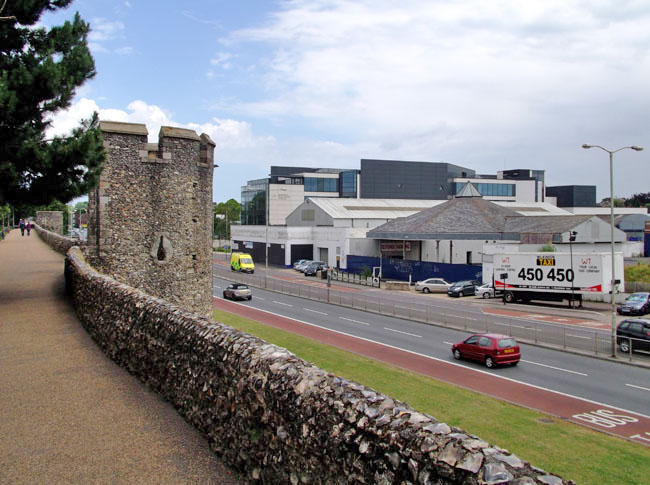 |
| With which we headed south to the white cliffs of Dover |
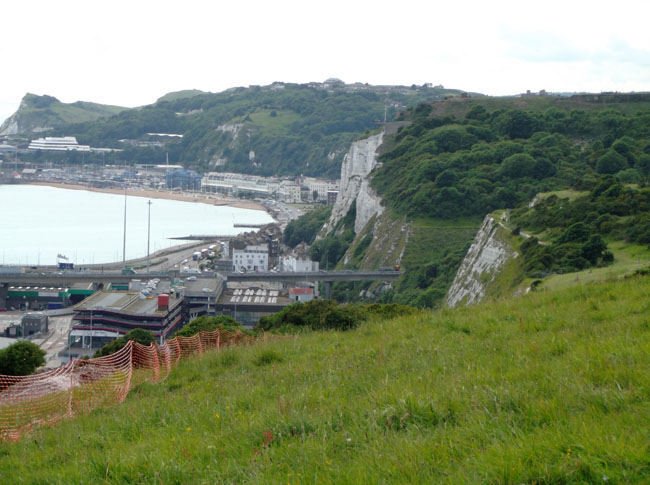 |
| Hiking the (displaced uphill due to construction) trail along the cliffs, we found ourselves above the harbor handling ferries on their way to and from France. The P&O goes to Calais. |
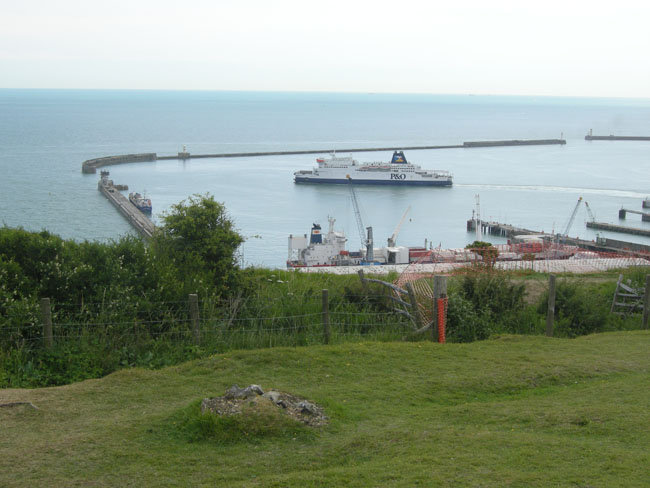 |
| It was clear! We could even see France |
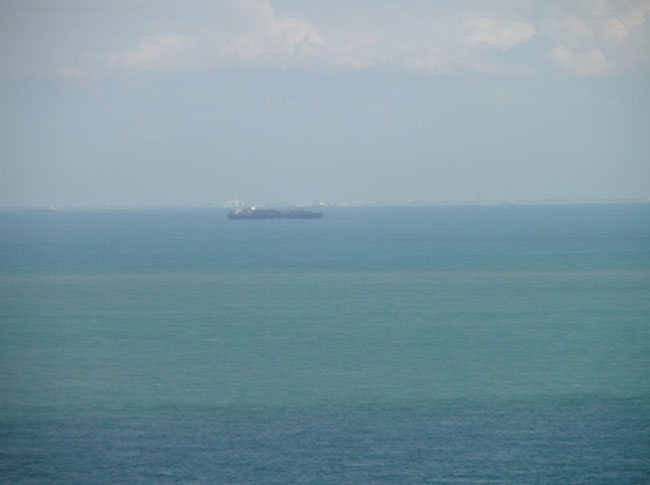 |
| And we walked on the famous white cliffs. |
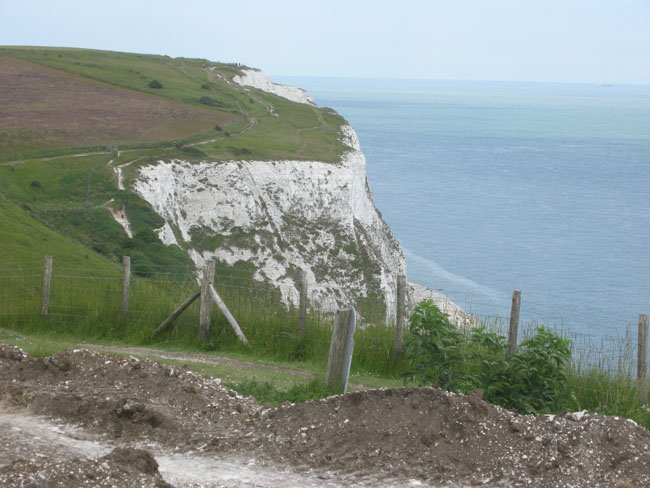 |
| Journeying westward, we began to run into the problem of "No Vacancies". We found a slightly-off-the-path campground in Pevensey within walking distance of the shore |
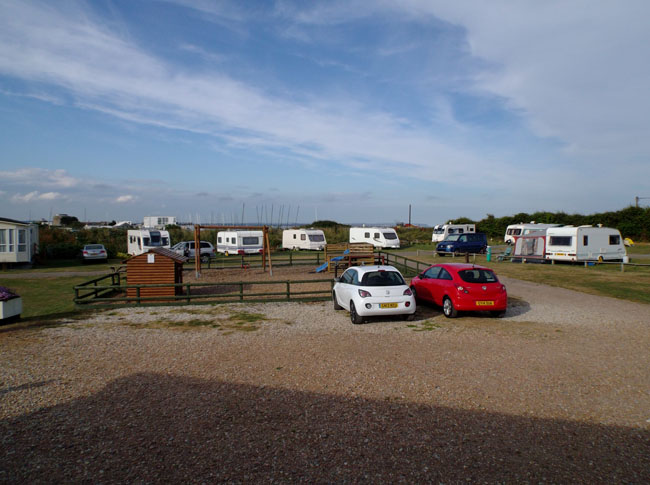 |
| Which had some of the few remaining Napoleonic-era "Martello" towers spaced 500 yards apart along the shore. (the cannons mounted in the towers had a range of 250 yards). |
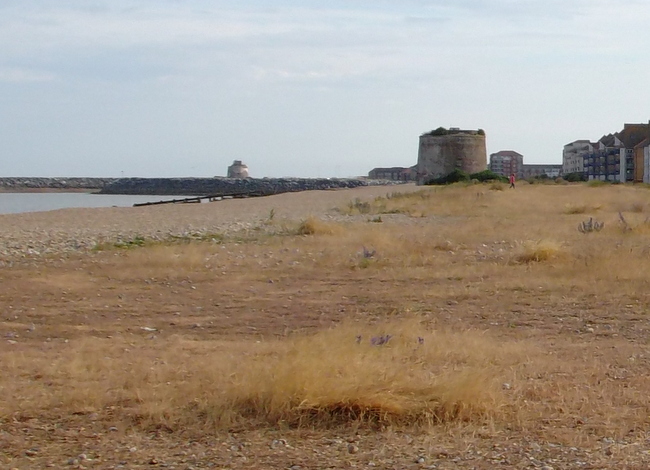 |
| We agree! |
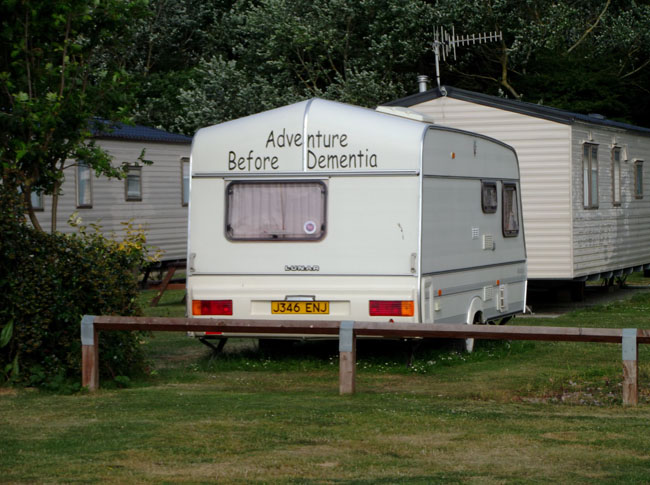 |
| Luckily we had no problems -- but neither did we leave anything outside. |
 |
| Going west along the shore in the morning we stopped to look at what appeared to be a beach retention project. |
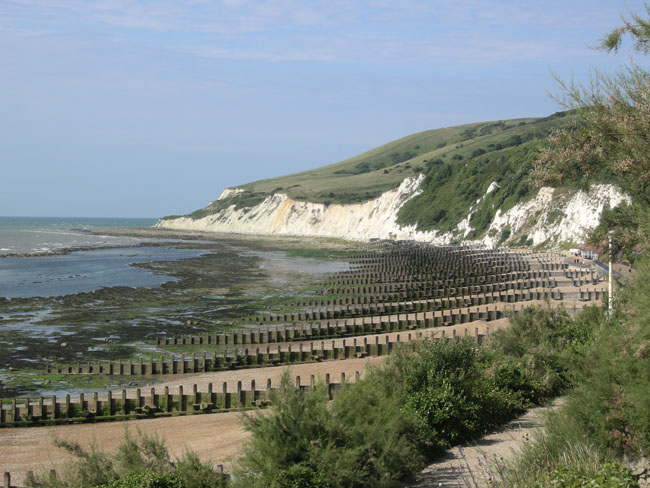 |
| We then spent a few hours in South Downs Park, which includes dramatic Beachy Head |
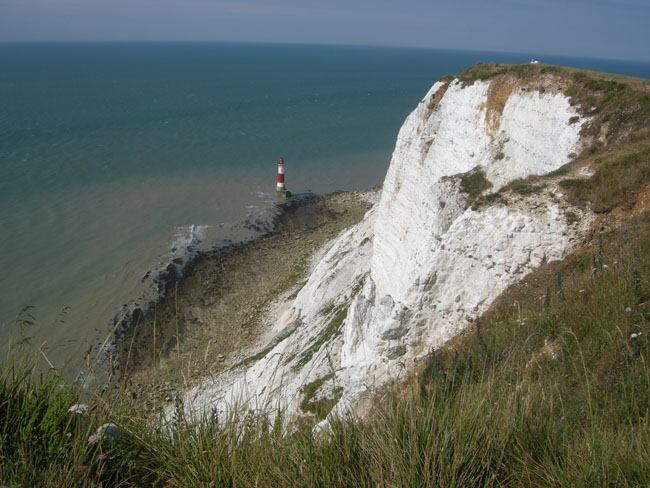 |
| And the cliffs called the Seven Sisters |
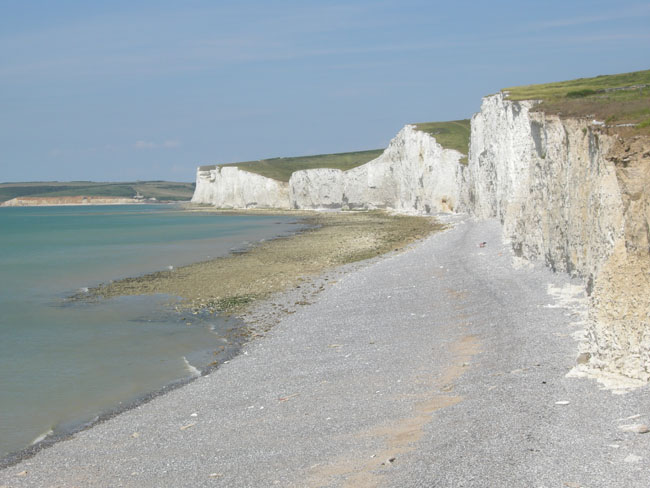 |
| Note the layering of the chalk and the flint inclusions. |
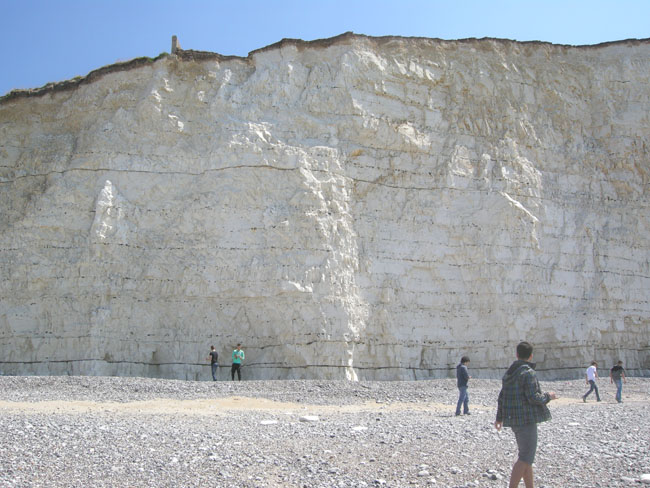 |
Don't stand too close to the top,
don't stand too close to the bottom. |
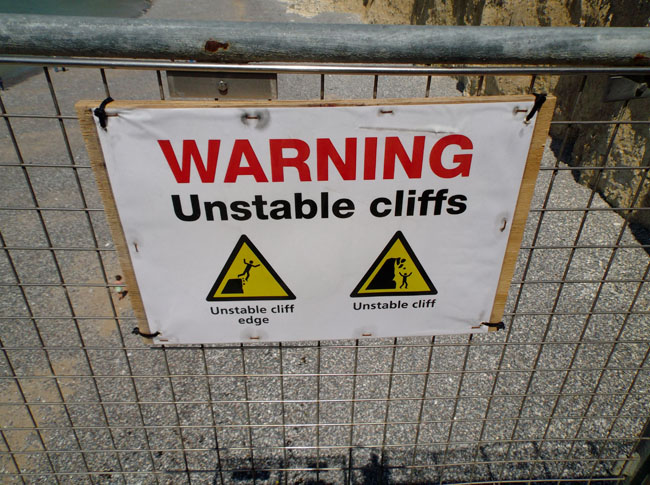 |
| The National Trust provides beach access via a steel staircase at Birling Gap (with tea shop (shown), of course) |
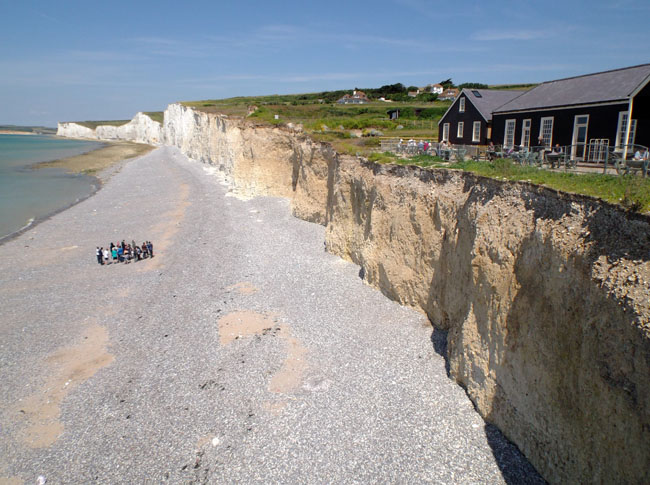 |
This is inside the tea shop's attached exhibit hall. The line is where they expect(ed) the cliff edge to be by 2053. January through March of 2014 had "ten years of erosion in 3 months", so the line may be a bit optimistic.
(average erosion rate at Birling Gap: 0.7 meters per year) |
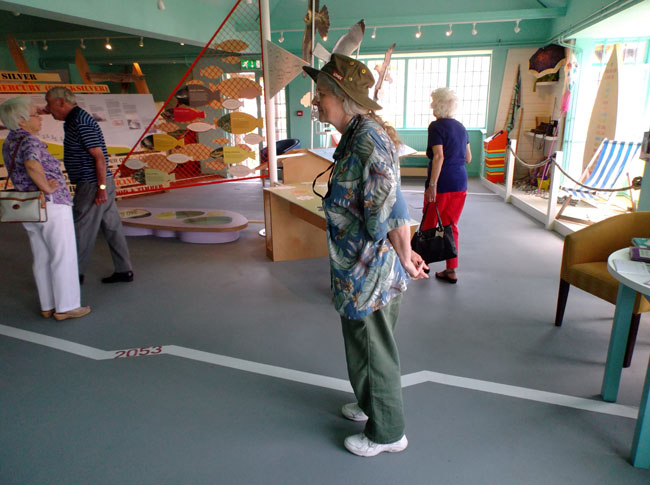 |
| Since the tea shop only served tea and light sandwiches, we continued on to Peacehaven for a more substantial lunch at the cliff-top Smuggler's Rest pub ... |
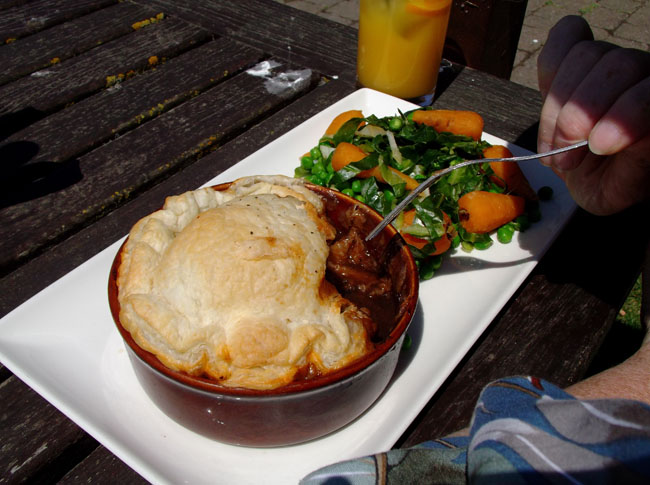 |
| ... which had the usual feathered clean up crew |
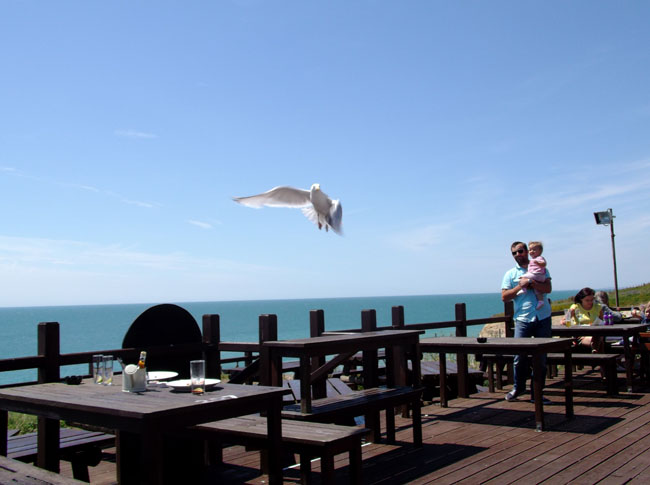 |
For folks contemplating a similar trip, there's the inland 70 mph fast route (A27) or the 30 mph scenic route (A259). Guess which we took.
Brighton pier is in the distance. |
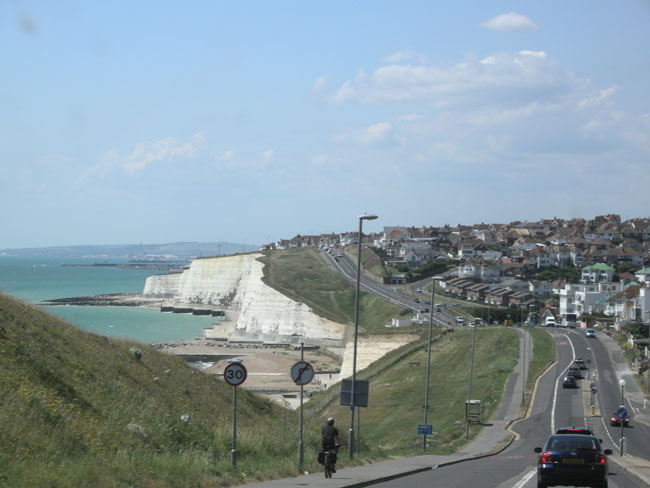 |
| and up close |
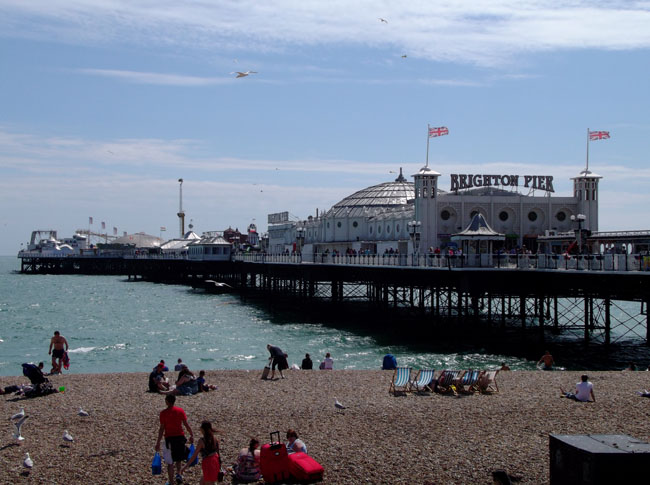 |
| And the view back to shore. Brighton is England's classic "Coney Island" (and predates Coney by a hundred years or so). |
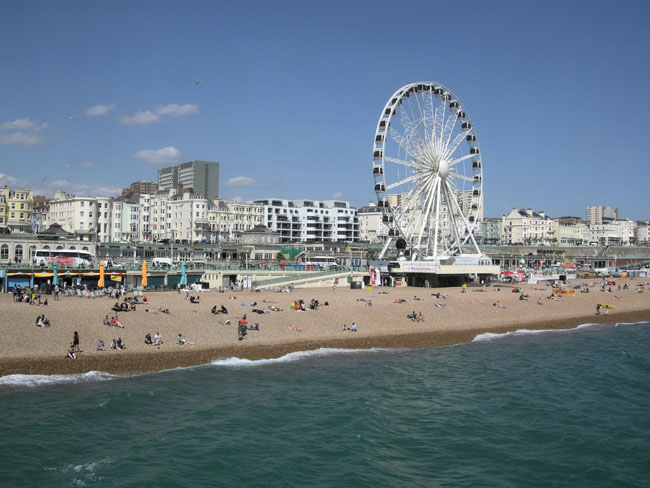 |
| |
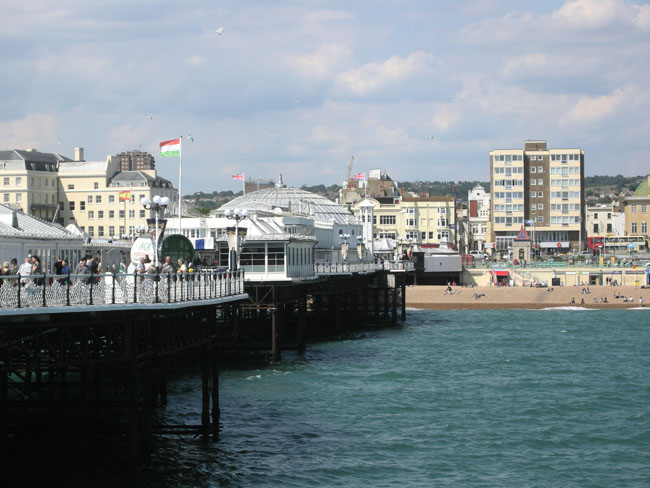 |
After a month of Cathedrals, Castles, Roman Ruins, hedgerows, stone-walled sheep-filled fields and the like, a touch of unembarassed tawdry was refreshing.
The experience was exactly what we expected but even more so. |
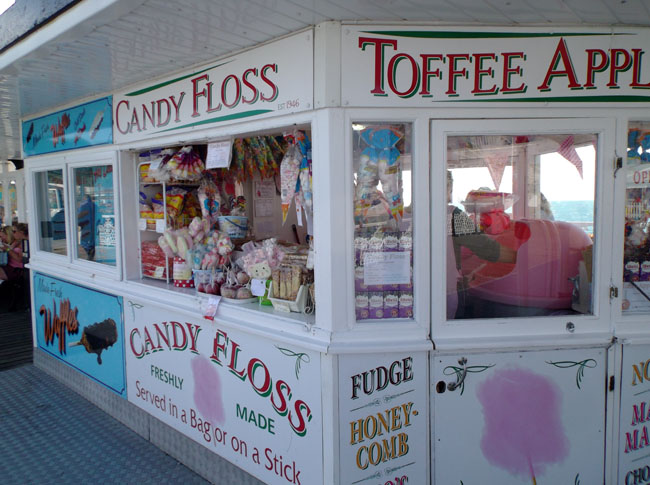 |
Going from the ridiculous to the tranquil (via an absolutely horrid in-Brighton traffic jam), Graffham Camping and Caravanning's forested campground took (more than) a bit of finding. Unlike the usual grassy/gravel field of UK sites, this had pitches as individual secluded glades amongst the trees and large rhodedendrons.
In many ways it reminded us of campgrounds in the Pacific Northwest, near our home in Seattle. |
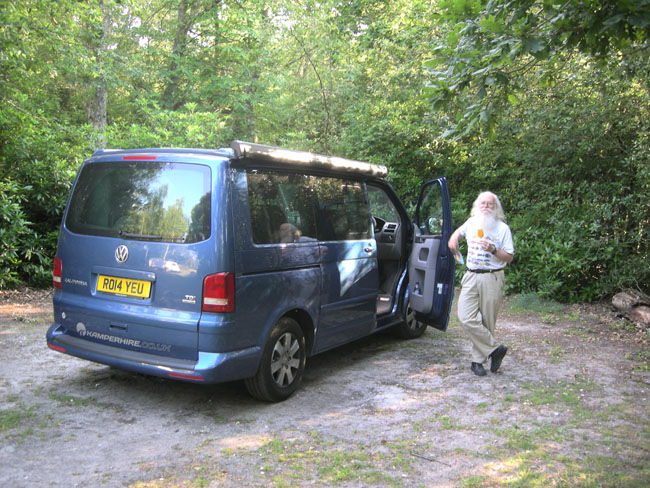 |
| The seclusion had some disadvantages: in the morning we discovered that something, probably a squirrel according to the camp host, had chewed the extension cord |
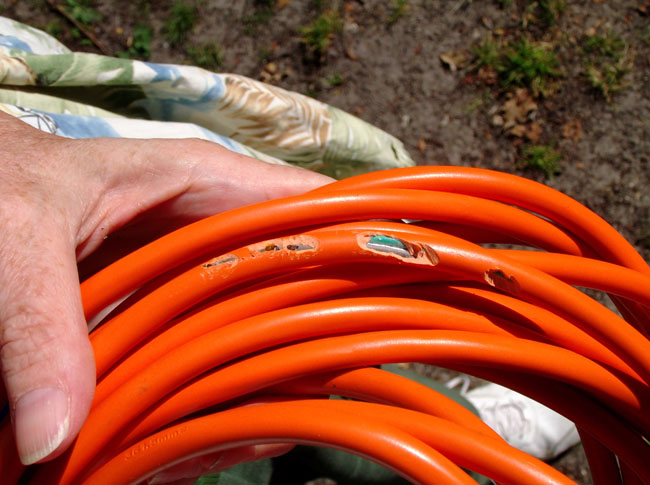 |
| With the VW nearing its home territory, we stopped in the morning to look at the mosaics (and gardens) of the Fishbourne Roman Palace near Chichester. |
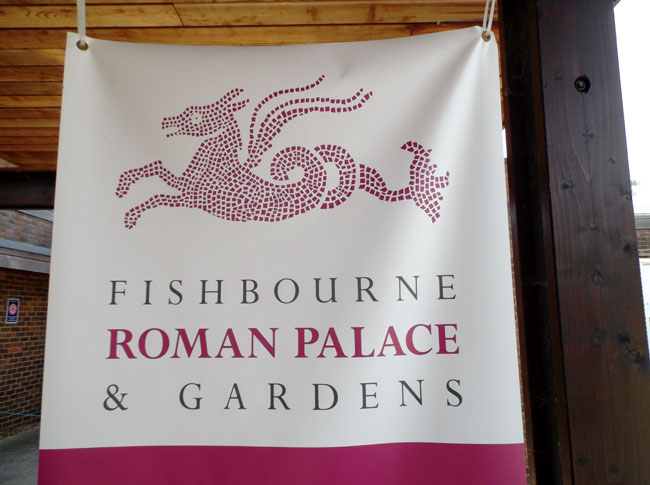 |
Sigh... ain't it always the same? One day you're just digging a trench for a water pipe, and the next you're committed to excavating and preserving a 2000-year-old estate that's larger than Buckinham Palace.
Part of the excavation was displayed under a roof and part re-buried to protect it. |
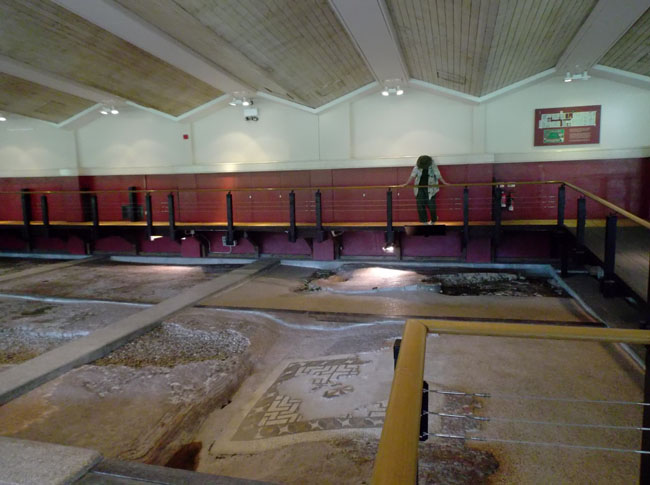 |
| The original building covers almost 6 acres. The part that's fully excavated and displayed in the modern museum is only the "north wing", which we've marked with the red lines on this model. |
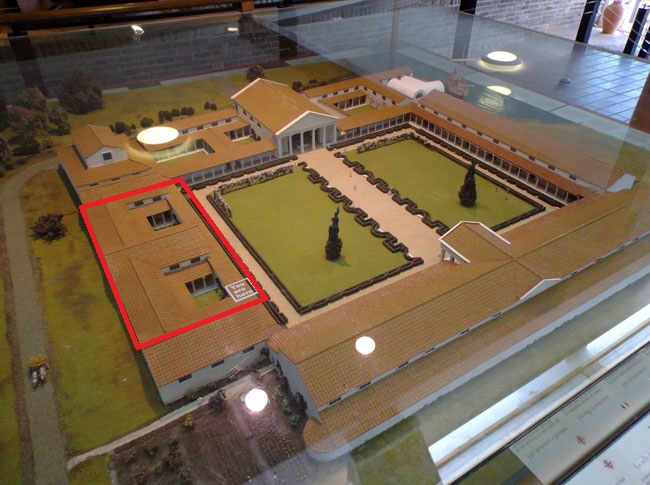 |
| With floors like this you wouldn't need carpets, especially since ... |
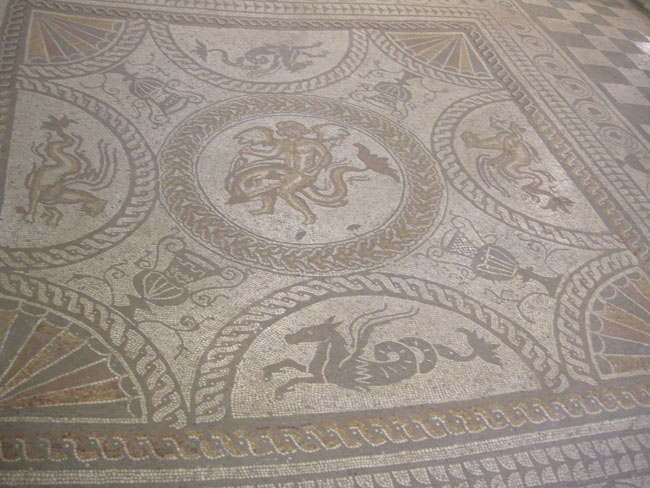 |
| ... they had under-floor heating similar to that seen at Bath. |
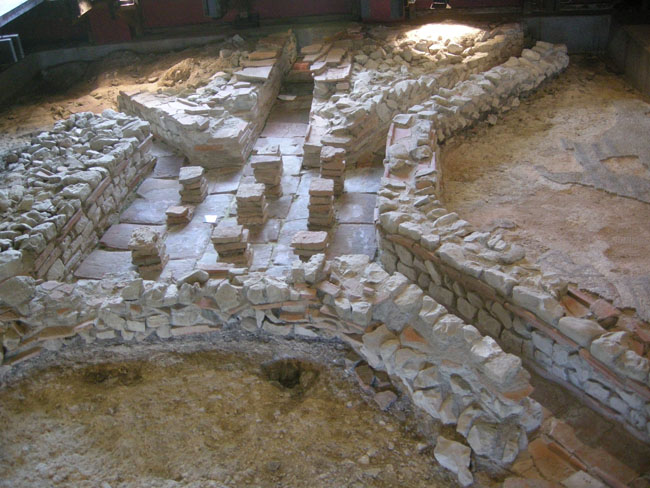 |
All told, there were about 20 major rooms (plus many closets and hallways) exposed within the museum's building.
They were having a bit of a problem with algae growing in some areas of the display. |
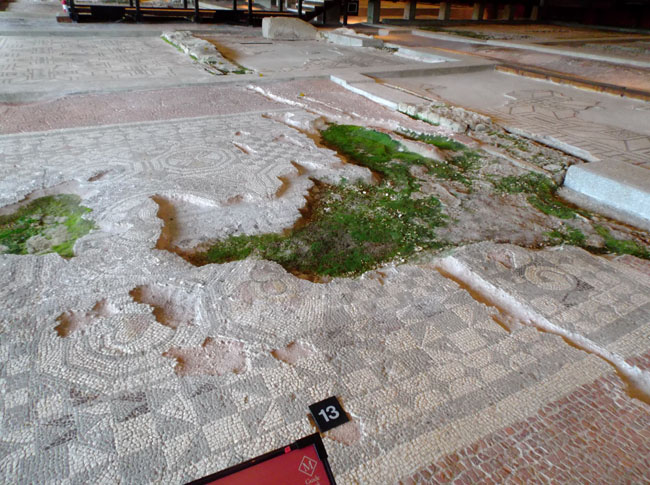 |
| There was a fine little museum explaining what life was like during the time the site was occupied. The adjacent Discovery Center provides access to the conservators at work and the half-million artefacts that have been uncovered so far. |
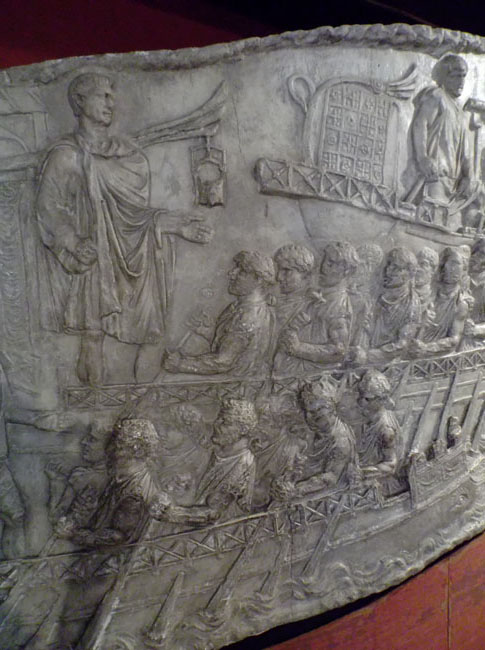 |
| Stepping out into the old central courtyard, they've replanted the gardens as best they could determine. |
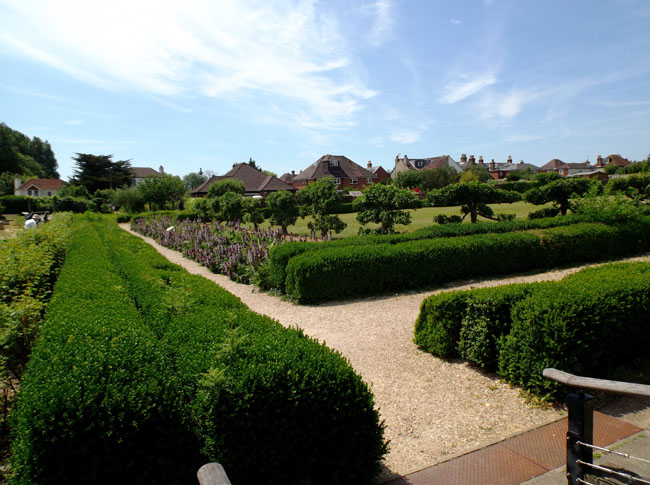 |
| Including the construction of a Roman style platform where feasters would lounge and eat under the grape vines. |
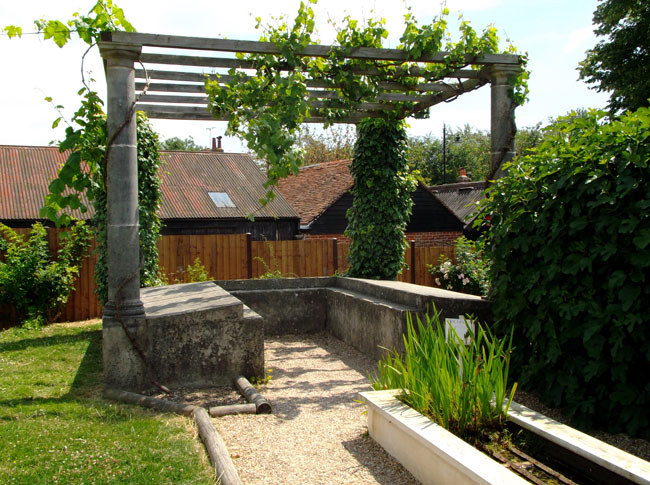 |
Archeology is demanding and time-consuming work. The gift shop may have found a way to ensure a steady stream of new workers...
(inset photo from
visitor's brochure)
 |
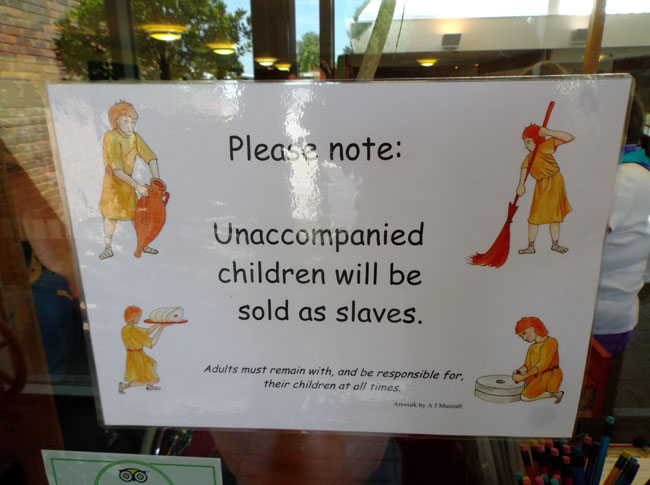 |
That evening we returned to the same Morn Hill campground which had seen us on our first two nights in England.
The next morning we took the local bus to Winchester so Dick could finally take a break from driving. |
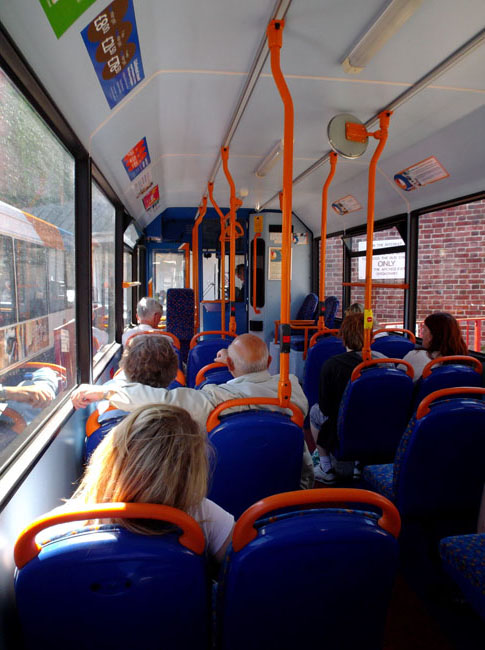 |
| We spent time seeing things in Winchester that we'd missed before, such as the town gates and its little museum we hadn't explored on our first visit. |
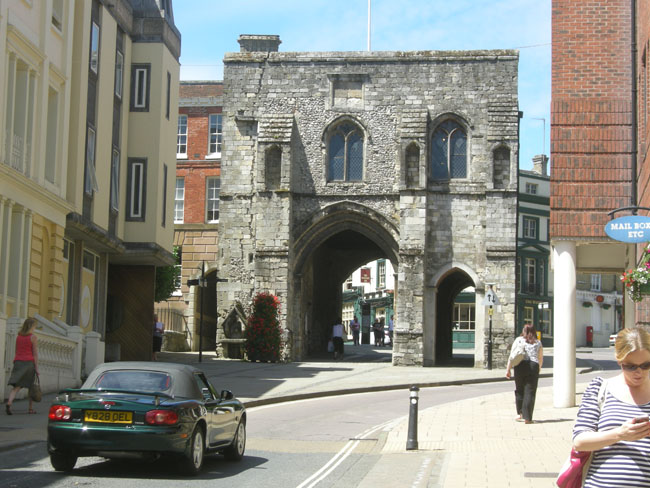 |
| |
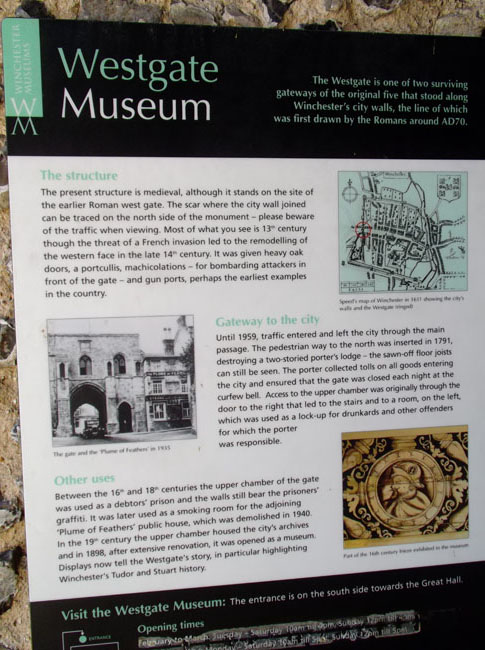 |
| Amazing! A (mostly) straight staircase! |
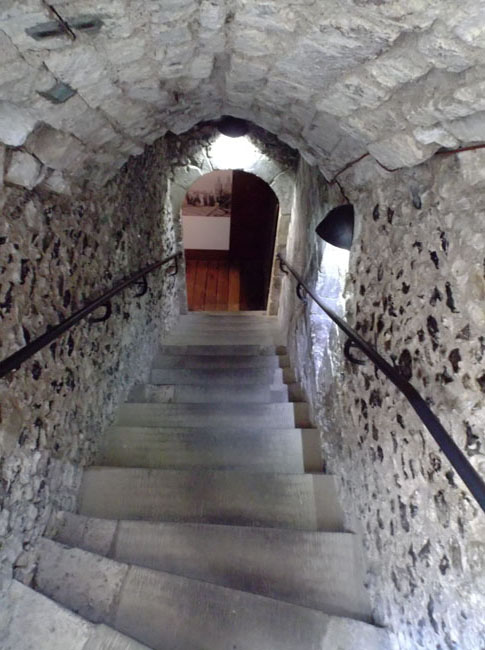 |
| The Guild Hall |
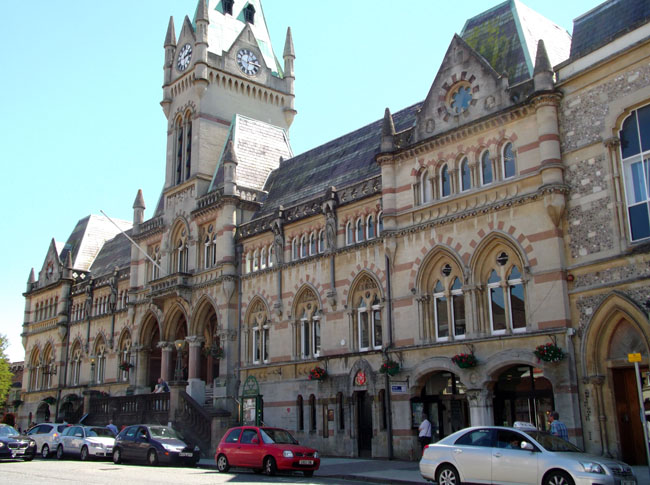 |
| and the Cathedral |
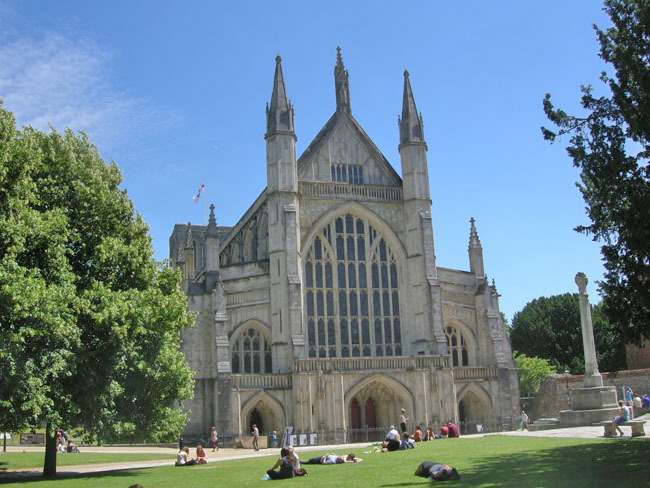 |
| and exploring a little public garden |
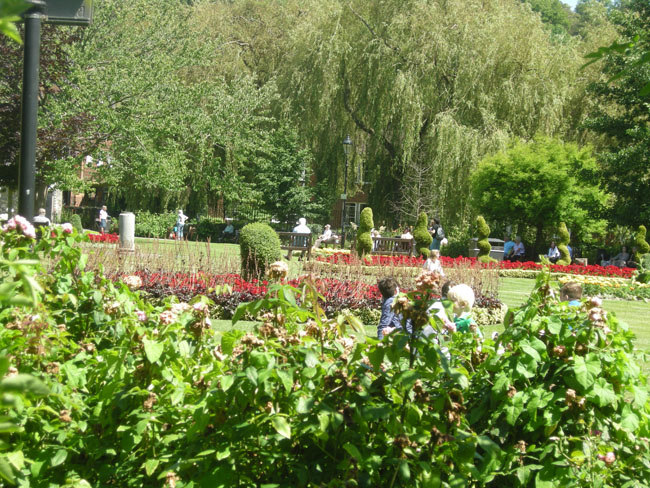 |
| There were several relatively new buildings but most worked at blending in. Notice the golden arches? After a bistro lunch near the cathedral (and a caramel frappe for dessert from this building) we went back to the campground to finish packing and cleaning the van. |
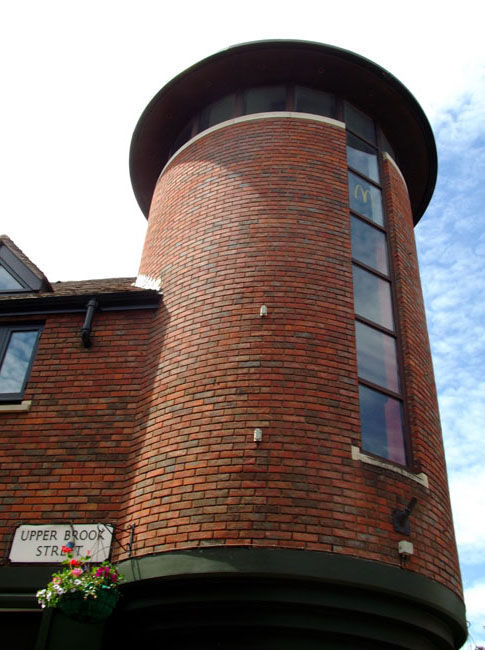 |
The next morning we dropped off the VW.
Mark at KamperHire had Dan, a local taxi driver, whisk us up to Heathrow. An hour of fascinating news and views of the area.
Four hours later we lifted off into clear skies ... which soon clouded over as we flew north. We never did see Ireland. |
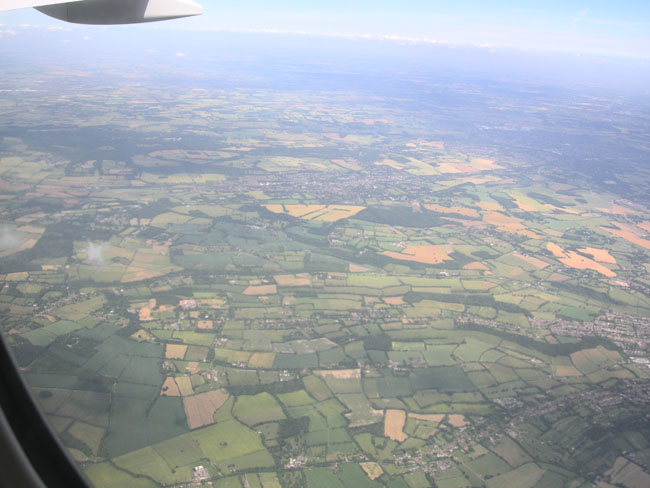 |
| But the skies clear for Greenland. We could even see the icebergs off the coast. |
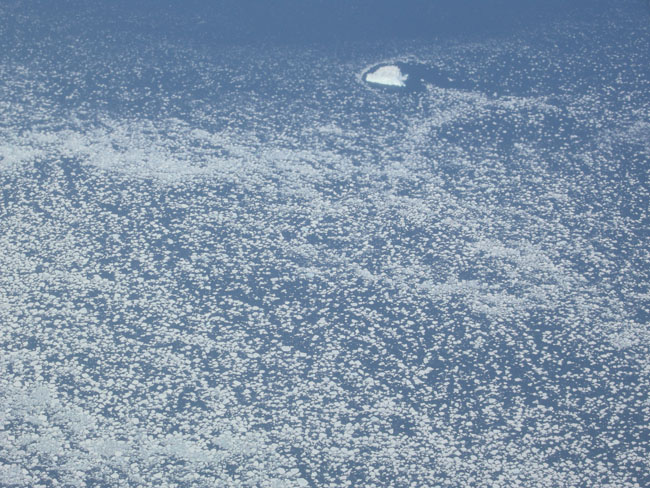 |
| and the permafrost areas of far northern Canada just west of Hudson's Bay. |
 |
Our flight east had been overnight with the sun barely setting. This flight west was during afternoon daylight the entire way.
What we saw out the window ... |
 |
| ... pretty much matched the seat-back display's identification. |
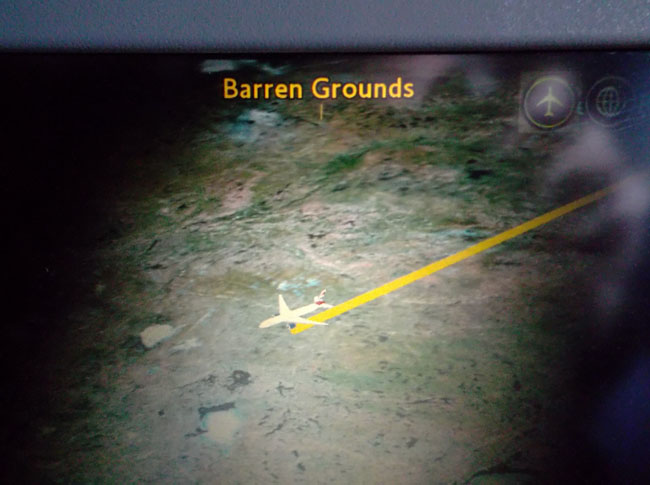 |
| Eventually we spotted home out the window |
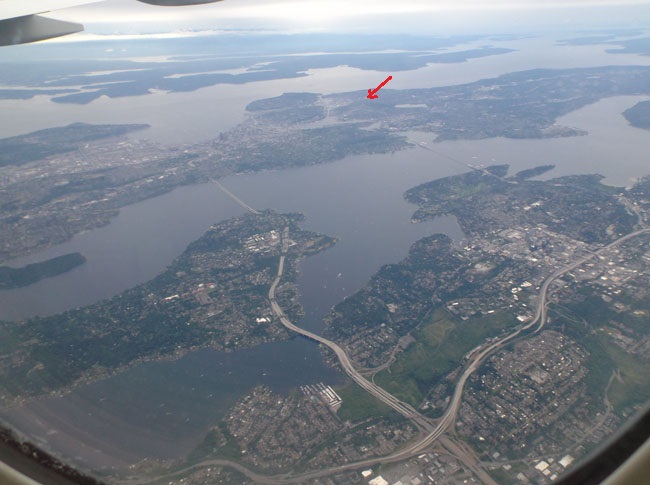 |
| And were greeted by Mt. Rainer |
 |




































































































































































































